Estimated reading time: 65 minutes
JD’s Plumbing, and HVAC company is sharing this guide to provide a comprehensive look into regular HVAC maintenance, repairs, and common HVAC problems.
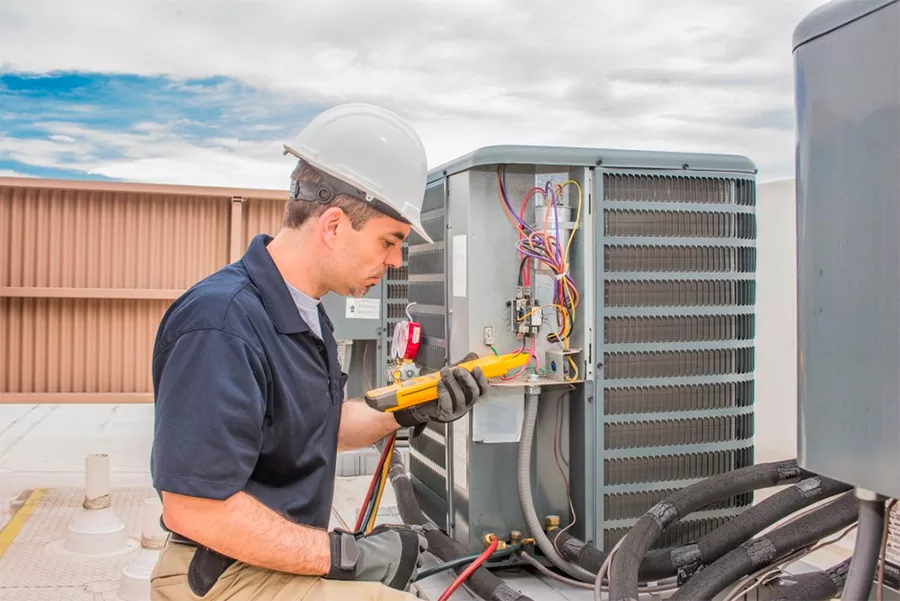
- Air Conditioning Maintenance
- Common Air Conditioner Problems
- Poor AC Airflow
- How to Tell if Air Conditioner Thermostat is Bad
- DIY Air Conditioning Maintenance
- Professional A/C Maintenance
- AC Maintenance in Denver, Colorado
- What is Heating System Maintenance?
- Heating Systems: Overview
- What Is an HVAC System?
- Types of Heat Systems
- Heating System Parts and Purpose
- Heater Maintenance Checklist + How-To
- Heating Maintenance FAQs
- Get Heater and Furnace Maintenance In Denver, Colorado
Air Conditioning Maintenance
Regular professional AC maintenance on your air conditioner is essential to keeping it running efficiently, reducing your long-term utility costs.
Tuning up an A/C unit ensures that the system works in optimal condition, reducing energy consumption and the amount of money spent on repairs or replacement parts. Knowing the basics of air conditioning maintenance will help you save time, money, and aggravation down the line.
By understanding your Denver HVAC system, homeowners can handle some simple DIY tasks, like changing air filters monthly and cleaning evaporator coils every two years at a fair price.
Occasionally more involved work needs to be done , like duct cleaning or calibration of thermostats, which requires hiring a professional AC contractor for help.
Professional maintenance services will give you peace of mind knowing that everything is working properly and all necessary repairs have been made before any larger issues arise from neglect.
How Important is AC Maintenance?
A working AC is one of the most valuable comfort factors in Denver, CO. Being in the desert, the often oppressive summer heat and intense sunlight can take a toll on people living here. Without air handlers, many in Denver would not be able to survive, as temperatures could reach upwards of 110°F in the peak of summer.
Air conditioners first became widely available after World War II, and the increased prosperity of America allowed people to purchase them. Around this same time, the population of Colorado started to skyrocket as more and more people flooded into the city, seeking refuge from the heat. This boom in population also highlighted why it’s so important to perform regular maintenance checks on air conditioners — as failing air conditioners in businesses or homes will result in an unbearable day-to-day experience for those living in Colorado who rely on it daily. Regular maintenance helps ensure everyone stays cool during even the hottest temperatures outside.
- Extending the life of your air conditioner.
- Investing in preventive maintenance can help you reduce costs in the long term.
- Increase the efficiency of your air conditioner to lower electricity costs.
- Improving the air quality in your home can provide numerous health benefits.
- Maintaining consistent temperatures in every room can help create a comfortable home environment.
Developing a strategy for air conditioner maintenance is important to achieve all these benefits.
Best AC Maintenance Strategies
Maintaining an air conditioner may seem complicated, but it doesn’t have to be! Thanks to the help of our dedicated professionals, developing a successful maintenance strategy for your unit is surprisingly simple. You can take three main steps to ensure your equipment is running optimally and at its best performance.
- Learn the basics about your system. You need to understand its function to maintain it and detect any potential issues properly.
- Become familiar with common air conditioner problems and solutions. Then you will know what to do when something goes wrong.
- Educate yourself on some DIY maintenance tips. This can help extend the life of your air conditioner while helping keep repair costs down.
This last step can also save time by allowing you to address smaller issues before they become big problems. Taking these precautions now will pay off in the long run!
Common Air Conditioner Problems
Recognizing the need for AC repair in Westminster, or routine maintenance is the first step to getting your air conditioner fixed and running efficiently. Air conditioning issues can often be difficult to diagnose and costly to solve, so it’s important that homeowners understand some of the most common problems their systems may experience. Knowing what is happening with your AC unit will help put you at ease and make informed decisions when deciding how best to handle any issue.
A few common AC problems include clogged filters, frozen evaporator coils, insufficient airflow, electrical control failure, and refrigerant leaks.
- Clogged filters reduce airflow, which in turn lowers efficiency and results in higher utility bills
- frozen evaporator coils form when warm air isn’t properly circulating through them
- insufficient airflow can mean a fan motor needs replacing
- electrical control failure could be due to problems within the thermostat or faulty wiring
- refrigerant leaks can occur from time-to-time due to aging systems or damage from outside elements.
With proper knowledge of these possible issues, homeowners should feel more confident about tackling basic repairs themselves. Only consulting professionals if necessary.
Poor AC Airflow
When a home’s AC unit fails to deliver adequate airflow, it can be unsettling and often frustrating. You pay good money for the cooling system, but it hardly puts out any cold air. Unfortunately, this is an all too common problem for those with air conditioning units. Ideally, you’ll want to quickly identify the root cause of the issue and get it fixed as soon as possible.
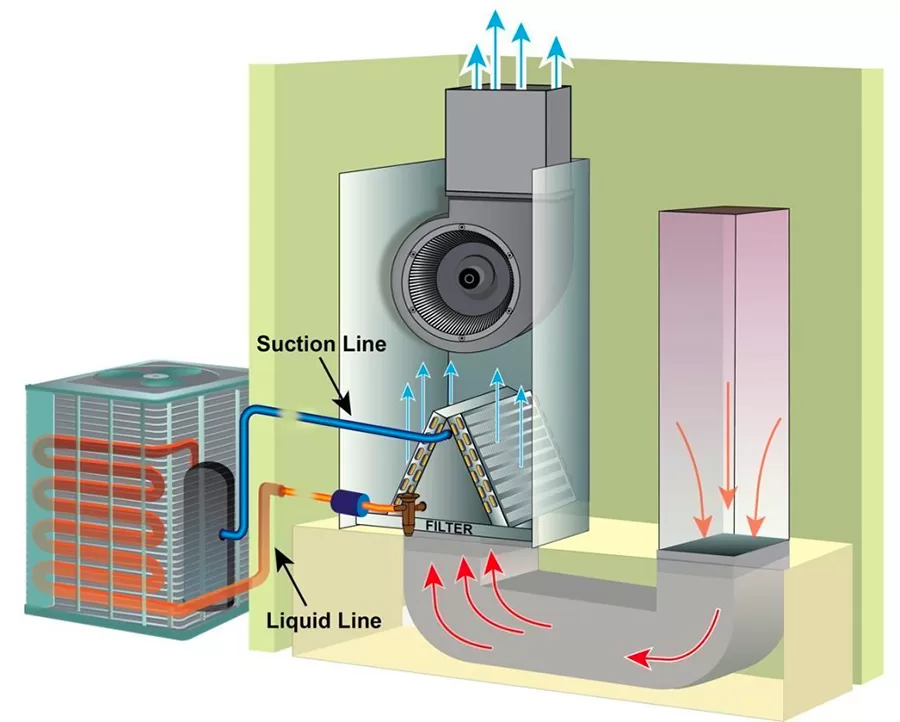
Usually, poor AC airflow can be attributed to a few key causes.
These might include something simple like:
- blocked or dirty filters that need replacing or cleaning to allow airflow again
It could be due to more serious issues such as:
- refrigerant leaks in the system, which must be addressed by an experienced air conditioning company as soon as possible.
- malfunctioning fan motor–if this part no longer functions correctly, the cooled air will not circulate through your house.
Though various other issues may lead to an inefficient air conditioner, these mentioned problems tend to appear most frequently.
Blocked or Damaged Ducts
Ductwork is essential to any home or business, providing ventilation, proper airflow, and adequate cooling or heating. However, the air flow can be impacted if your ducts become blocked or damaged. When this occurs, you start to feel the effects immediately. Temperature regulation and comfort level will change, but you can also end up paying higher energy bills as a result.
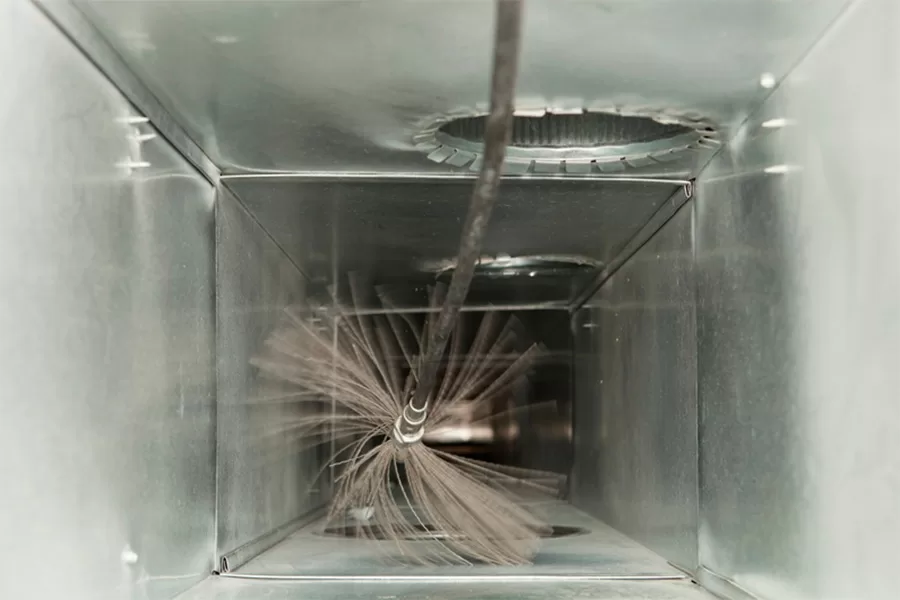
The most common cause of obstructed air movement through ducts is debris buildup, such as dirt and dust. This debris promotes the growth of bacteria and fungi, which can eventually restrict airflow in your system. In some cases, entire portions of a drain might even become blocked with different materials, such as insulation, meaning air won’t move through it at all. Leaks in ductwork also inhibit air flow by allowing treated air to escape into walls or other areas where it doesn’t belong instead of being delivered to its destination. Fortunately, if caught early enough, blocked or damaged ducts can often be remedied with some cleaning and repair work from a professional contractor.
Clogged or Dirty Filters
The importance of having a clean filter in your HVAC system cannot be overstated. Filters help to protect your ductwork from getting clogged and dirty. This ensures the air inside your home or business remains clean and free of debris. Unfortunately, these filters can get caked up with dirt and dust particles over time, making them less effective at trapping air pollutants. When this happens, replacing or cleaning the filter is important to restore its effectiveness.
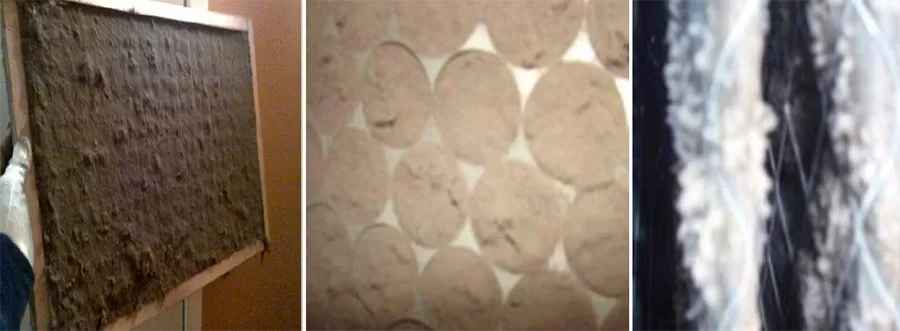
Cleaning or replacing a clogged or dirty filter is a relatively simple task. To begin, identify if the filter needs to be replaced or if it can be cleaned. Cleaning usually involves removing the filter from the housing unit and using a vacuum cleaner to remove dust and debris. Afterward, reinstall the filter back into place within its designated housing unit for optimal performance and improved airflow. Remember to install new filters regularly for maximum protection of your environment against unwanted pollutants.
Covered Vents or Dampers
It is important to check your home’s ventilation from time to time, especially if you have noticed that one particular room is particularly uncomfortable compared to others. Sometimes, it may be due to vents or dampers getting stuck in the closed position and preventing air from properly circulating. To remedy this problem, physically inspect the furnace and any return and supply vents around the house to see if any are blocked or closed. If any are found blocked, use a vacuum cleaner with an attachment brush to remove any dust or debris which might be obstructing the vent’s opening.
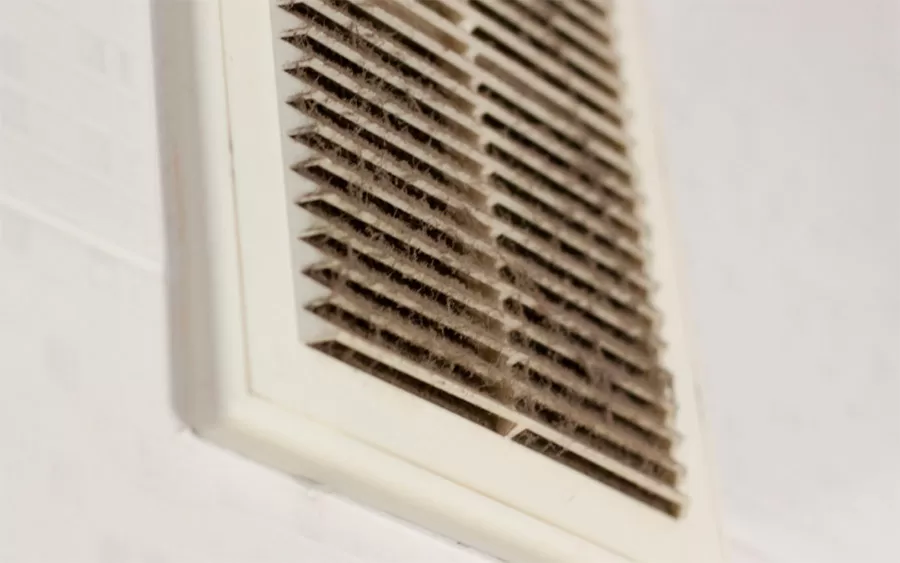
Another issue that can prevent healthy airflow throughout your house is when furniture and rugs are placed over the vents. This obstruction can cause the damper valve to close more than usual, thus significantly reducing airflow in a particular room. To avoid this problem, ensure all vents are unobstructed and free of objects that could block them. Additionally, regularly clean all AC filters throughout your home as they tend to accumulate significant amounts of dust over time, which can restrict proper airflow and cause health problems for people living in the household.
Incorrect Ductwork
The wrong ductwork can be a huge issue for anyone with an HVAC system. If your ductwork is too large compared to your HVAC unit, it will have a hard time pushing out enough air to fill the ductwork to supply cool air to all rooms efficiently. This will lead to a less comfortable room temperature and, eventually, higher energy costs. On the other hand, if the ductwork is undersized, it won’t be able to accommodate all of the air produced by your HVAC system, leading to a decrease in efficiency that doesn’t properly cool or heat all areas of your home.
If you did not have new ductwork installed, it is unlikely that compatibility will be an issue. If you’re noticing issues with heating and AC in certain parts of your house, it could mean that something is off with your current ductwork setup and needs adjustment or replacement. It’s important to determine what size your ducts should be and ensure they match up with your current HVAC system before any major proceeding.
Blocked Condenser Coils
A condenser coil is one of the most important components in an air conditioning system. It helps transfer the heat collected inside your home back to the outside, ensuring your house remains comfortable and cool. However, if the condenser coils are obstructed by dirt, debris, or other materials, it can cause several problems.
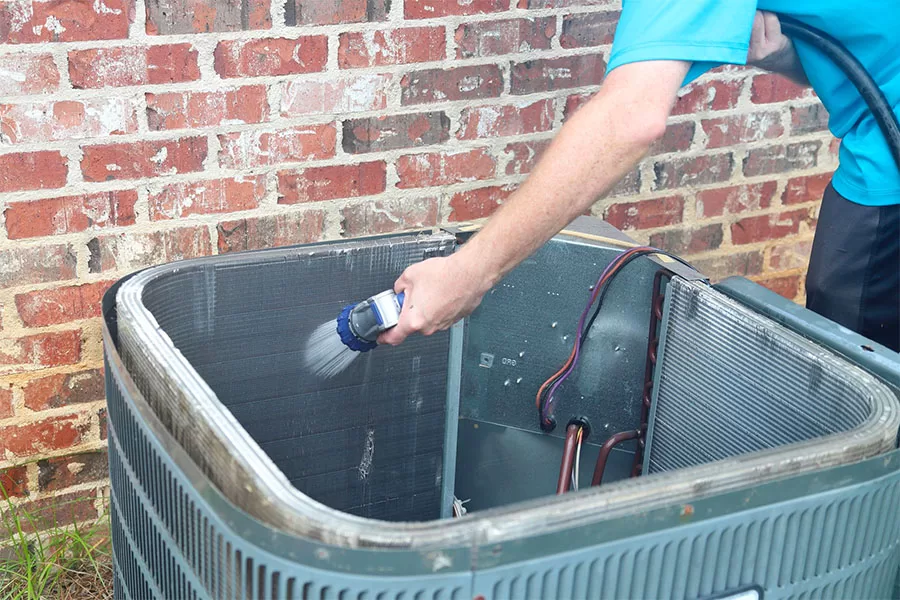
Due to their obstruction, condensers can no longer properly transfer heat away from your home. This leads to airflow problems, potentially overheating, and short cycling of your AC unit. To prevent this, you must regularly clean and maintain the outdoor unit of the air conditioning system. This involves preventing any obstructions or build-up of dust and dirt, which can prevent efficient heat transfer away from your home. If you do not properly maintain your outdoor unit, you risk putting unnecessary strain on the system that could lead to more costly repairs.
How to Tell if Air Conditioner Thermostat is Bad
Having problems with air conditioner thermostats can be both good and bad news. The good news is that if the thermostat has the wrong setting – due to a friend or family member playing around with it – then there is a good chance that this can quickly and easily be corrected, allowing you to retain control of your AC cooling system and get it feeling right again.
Suppose the thermostat is correctly adjusted yet fails to function. In that case, the underlying cause could be its inability to read the temperature inside the home or send signals to other parts of the air conditioning system. In either case, one should seek outside help to rectify the issue as soon as possible – this could come in the form of technical support from an experienced company specializing in air conditioning installation, AC repair service and maintenance services. A broken thermostat replacement is not always necessary, as the issue can sometimes be resolved with simple calibration.
How to Program Your Thermostat
Programming your thermostat is essential for energy efficiency and cost savings. By setting your thermostat to adjust the temperature based on your daily schedule, you can avoid wasting energy and money on heating or cooling an empty home.
To program your thermostat, read the manual to understand the features and settings.
Then, set your desired temperature for different times and days of the week.
Some thermostats even have smart technology that learns your preferences and adjusts accordingly. Programming your thermostat can significantly reduce your energy bill with little effort.
Electrical Problems With Air Conditioner
Poorly maintained electrical systems can be the source of significant headaches when it comes to air conditioners. To properly power an A/C unit, a wide range of electrical components must work together. The components will inevitably become worn or damaged over time due to vibrations and temperature changes. Wiring that carries the necessary power and signal to each component can also corrode over time due to moisture or condensation. When any component within the A/C system is not working correctly, it can cause electrical problems that prevent the A/C from turning on.
When there’s an electrical problem with an air conditioner, it may trip the breaker or might refuse to turn on. In either case, you should hire a professional to diagnose and repair the underlying issue to get your HVAC system back up and running as soon as possible. While such repairs can be expensive, they are usually much less costly than replacing an irreparably damaged compressor due to negligence in servicing a unit before real damage sets in.
Low Refrigerant in Air Conditioner
Refrigerant is an essential component of air conditioners. A chemical refrigerant is required to enable air conditioners to function properly; severe issues may result when this level is low. Leaks are likely the root of the problem and must be repaired promptly. Fortunately, there are a few signs that can help you diagnose this issue early on.
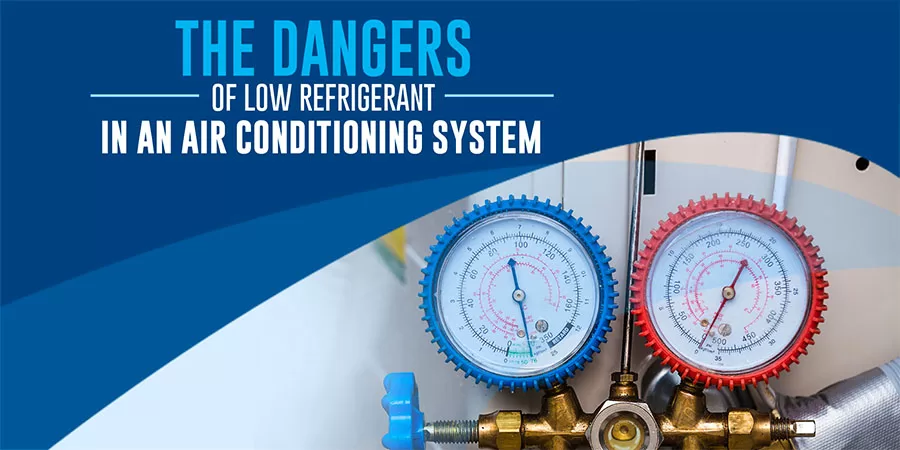
Watch out for hissing or bubbling noises from your A/C unit and any visible signs of frozen refrigerant lines. If you’re dealing with a blocked drain pipe, this could also indicate a leaking or low refrigerant issue. It’s important to address these issues quickly before too much refrigerant escapes into the environment, as the fumes created by leaking chemicals can be hazardous to your health if inhaled. If your refrigerator is running low on refrigerant, immediately speak to a qualified technician for professional help and advice.
The Air Conditioner Making Banging Noises
An air conditioner may produce various sounds, including a fan whirring and a compressor humming. But when you hear a loud banging noise inside your air conditioner, you have cause for concern. This indicates that something has come loose in the unit and is now rattling against other parts or its own body.
These rattling or banging sounds can put extra strain on the A/C system and ultimately lead to more serious issues, so it’s important to turn off your AC unit as soon as you hear them and contact an HVAC repair technician immediately. The technician will need to locate the source of the banging noise and determine if any other components have been damaged. In some cases, they may also recommend replacing worn-out or loose parts with newer ones as preventive maintenance. Even if no serious damage has been caused by the sound so far, having it checked out can help you avoid any potential problems in the future.
Air Conditioner Screeching Noise
If you hear a loud, high-pitched screeching coming from your air conditioner, it could signify several different problems. The most important is to turn off the system immediately to avoid further damage or the release of hazardous gas into your environment.
The culprit of the noise could be:
- The compressor motor is broken.
- The blower fan motor is broken.
- The fan motor has damaged bearings.
If left unchecked, a failed compressor motor can be very costly and dangerous, as it can release potentially harmful refrigerants into the atmosphere. Similarly, suppose a blower fan motor has had its bearings fail. In that case, the air-generating mechanism may become overworked and break down faster.
It is essential to have these problems attended to by a professional as they save time and money in repairs and protect against any long-term damage or hazards arising from not properly addressing an issue with your air conditioner.
Broken Condensate Airflow Switch
The broken condensate airflow switch is essential to any central air conditioning unit. The float switch is responsible for automatically shutting off the air conditioner when the drain pan is full of water. When this switch malfunctions, certain signs may indicate a problem. For example, your air conditioner may run continuously, or you may smell mildew or mold coming from your unit. Finally, if you notice leaking anywhere near the condensate pan, then it’s likely that the flow switch has malfunctioned or broken.
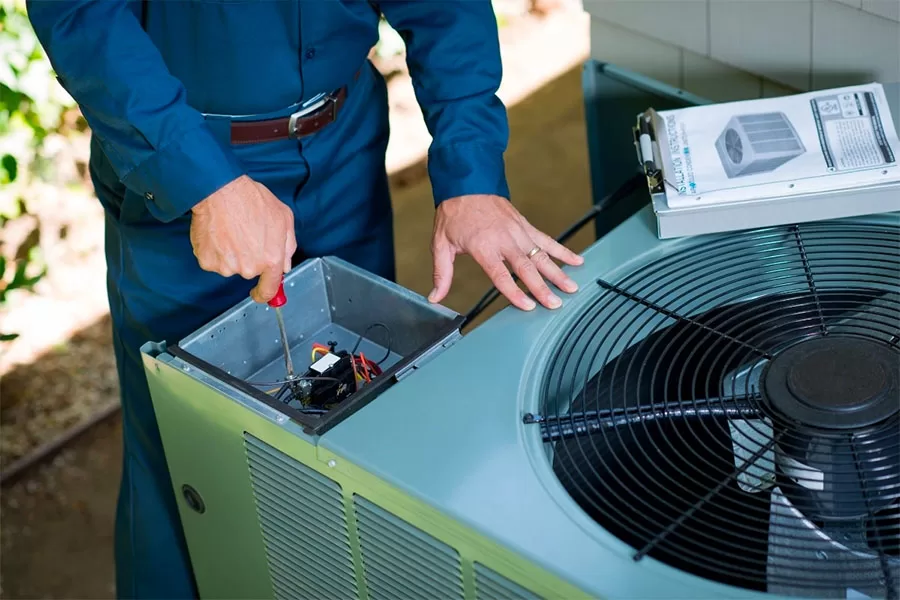
Suppose your broken condensate airflow switch is causing problems for your air conditioning system. In that case, a licensed professional should be called to inspect and repair the issue as soon as possible. If left unrepaired, not only will you have to put up with uncomfortable temperatures, but you could also be faced with much higher energy bills due to the inefficiency of your unit. If you notice any signs that point towards a failed float switch, don’t hesitate to get it inspected and repaired promptly.
Air Conditioner Drain Clogged
An air conditioner’s drain clog can be an annoying and frustrating problem, especially for older units. With newer models, some sensors can detect clogs, but most homes still have an older system. Therefore, pay attention to Filter changes and cleanings, as these are good times to check the drain pan to ensure water isn’t backing up anywhere.
If it is clogged, a few DIY unclogging methods may work depending on how far along the clog is. Snake cables and plungers are often effective solutions. However, they require a certain level of comfort and expertise to do the job right without further damaging the system. Plumbers or professionals may also be necessary if you don’t feel uncomfortable taking risks with such delicate equipment. In any case, it’s better to take action immediately once you notice an issue than wait so that it doesn’t get worse before signs of this phenomenon arise within your air conditioning systems.
Air Conditioner Freezing
Nobody wants to be stuck in the sweltering heat of Denver, Colorado, without a working air conditioner. Unfortunately, air conditioners sometimes get to the point where they freeze over and won’t work properly. When this happens, acting quickly and taking the right steps to get it running again is important.
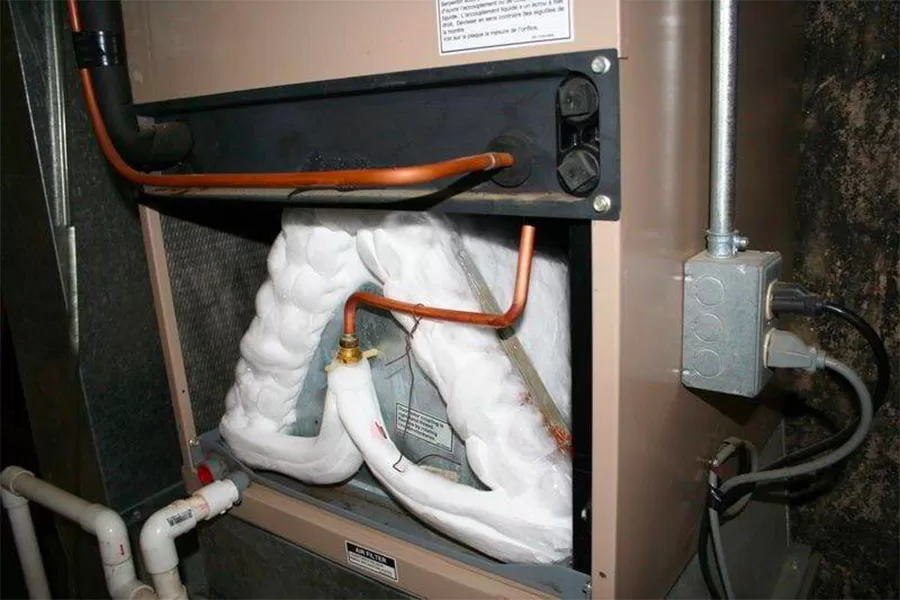
The first thing you should do when your air conditioner starts freezing is to turn it off until all of the ice melts and the parts can thaw out. Before trying anything else, inspect the unit for any visible signs of damage or problems with its components, such as refrigerant lines. Suppose there are no visible damages or problems. In that case, you may be able to solve the freezing problem just by replacing a dirty filter – something that can easily be done on your own with DIY maintenance instructions that are available online. However, if such attempts don’t fix the issue, you will likely need to call in an expert for help and have them look at the system.
DIY Air Conditioning Maintenance
Although calling in a professional air conditioning company for maintenance is sometimes necessary, there are still plenty of steps most homeowners can do to ensure that their AC system remains in top-notch shape. Understanding the basics of how your HVAC system functions are the initial step toward being able to maintain it and make any necessary repairs.
The most important DIY maintenance tasks are changing your filter regularly, clearing all drains and vents, ensuring the outdoor compressor unit is clean and free of debris, inspecting outdoor units for rust or corrosion, and checking refrigerant pressures and temperatures. If you’re more comfortable with going beyond basic maintenance tasks, you can also clean vents and ductwork as well as check electrical connections within the system. All of these routine maintenance items will help your air conditioner unit running at peak efficiency while reducing potential repair service costs down the road.
Know Your Unit
Assess the complexity of your unit. Older units are usually easier to comprehend and care for but may have experienced greater wear. In contrast, newer units often feature a lot of advanced technology, which may make them harder to manage.
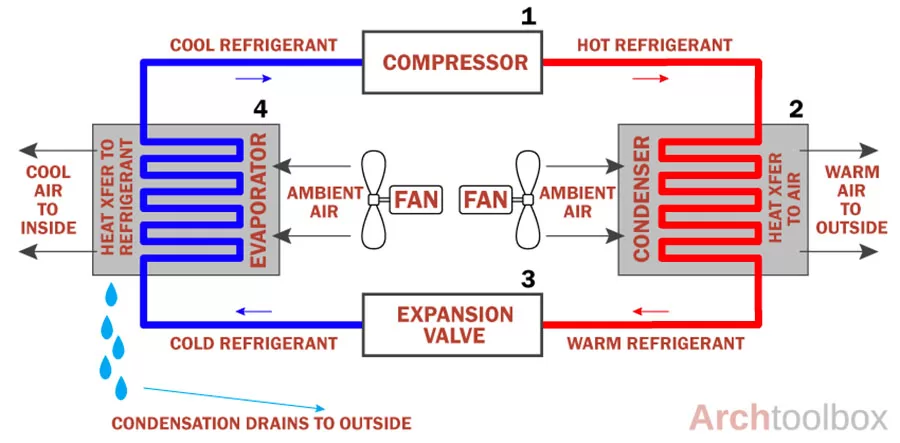
We will now take a general overview of the functions of an air conditioner, excluding any complex sensors or technologies.
- In a home’s evaporator, the refrigerant is exposed to warm air, leading to an energy gain and elevated temperature. The refrigerant is collecting heat from your home at this stage.
- The compressor transports the compressed refrigerant gas from indoors to a condenser unit located outdoors. Heat is released from the refrigerant into the outside atmosphere through fins attached to the condenser unit.
- The refrigerant undergoes a phase transition from gas to liquid, expelling heat and reducing temperature.
How to Maintain the Outdoor A/C Unit
Maintaining the outdoor A/C unit is essential to keeping your air conditioning system in good condition. This involves periodically inspecting and cleaning the unit and any other necessary steps that may need to be taken.
- Shut off the air conditioning system before performing any maintenance on the outdoor unit. You can either adjust the thermostat or use the switch on the unit to turn off the air conditioning.
- Make sure that any plants or debris are cleared from the unit. Leave sufficient space surrounding the unit on all sides, ideally at a distance of two feet or more.
- Inspect the fins on the exterior unit. To clean them, use gentle hosing. Be sure to apply the appropriate amount of force when spraying them in order to avoid bending. Bent fins need to be straightened.
- When cleaning the external portion of the air conditioner, caution should be taken when using a hose to ensure any moisture does not enter the motor. It is advisable to ensure water does not reach the motor when spraying the system, as it is designed for outdoor use and may be resistant to some moisture.
- The condenser fan needs to be cleaned. Dirty condensers can lead to increased issues and should be routinely cleaned for optimal performance. Clean the surface by removing leaves, dust, and other debris, then wipe with a damp cloth.
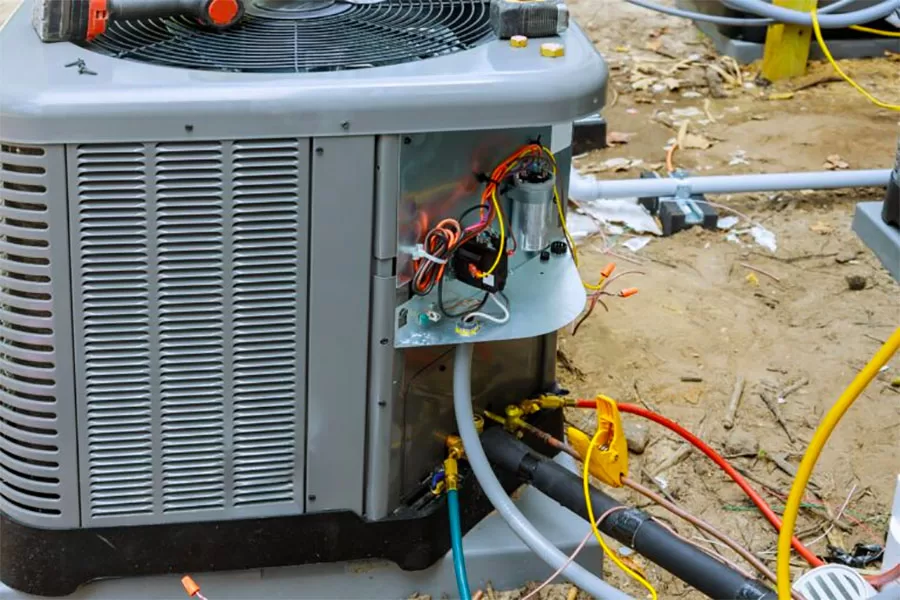
The next step in maintaining your outdoor A/C
The next step in maintaining your outdoor A/C unit is to remove any plants or debris that has gotten onto or into it. This could include leaves, branches, or other debris, which could cause blockages or obstructions if left unchecked for too long. After removing this debris, you should inspect all components of the outdoor unit for signs of wear and tear, such as rust or corrosion. Additionally, look for any loose wires or broken parts which could indicate a larger problem and require repair from an HVAC professional. Maintaining your outdoor air conditioning unit is important in keeping your home comfortable throughout every season!
Mind the Airflow
You can easily maintain good airflow in your HVAC system by taking two simple DIY steps. Furniture and dust should be kept away from vents, and they should be inspected regularly. If the vents become dusty rapidly, it may indicate that ducts require professional cleaning.
It is important to take good care of air filters. Changing the filter is a simple task most people can do themselves, but it is easily forgotten. An overly dirtied filter will reduce airflow and result in A/c freezing. Changing the filter every 90 days and at least every six months is advisable. If many people or pets live in your home, or if you have allergies, then plan to change it monthly.
Maintaining Your Indoor A/C Unit
It is essential to take proper care of your indoor A/C unit. Beyond replacing the air filter, regular maintenance can help ensure that the evaporator and blower within it operate at peak performance. Not properly caring for these components can lead to poor air quality, poor energy efficiency, and higher cooling bills. It is important to either learn how to do this yourself or have it regularly completed by an expert.
When cleaning these components, you may use a no-rinse coil cleaner. This solution helps remove dirt and other residues that have built up in your evaporator over time. When using a coil cleaner, be sure to follow all instructions and wear protective clothing such as goggles, gloves, and a dust mask. With regular maintenance and care taken concerning the indoor portion of your A/C system, you can rest assured that your unit is running optimally when it comes time for summer cooling needs.
Give Your A/C a Rest
Your air conditioner may be just another appliance to you, but it needs a little love if you want it to keep running as long as possible. Unfortunately, the weather in Denver puts a lot of strain on your system, and just like with humans, too much stress can shorten the life of your A/C. The easiest thing you can do for your air conditioner is to give it a break occasionally.
You can take some of the burdens off your system easily.
- Turning the thermostat by a few degrees on hot days will reduce your unit’s load and keep you comfortable.
- Keep curtains and blinds closed during peak heat hours; this helps block out sunlight and keeps your home cooler without straining your A/C unit as much. Keeping up these simple habits can have lasting effects that make living in Denver much more enjoyable!
- Starting a fan when entering a room can help reduce the amount of air conditioning necessary.
- Increase the thermostat setting when leaving the house for an extended period of time.
Professional A/C Maintenance
Performing regular maintenance on your air conditioner is an important part of owning a home. You can take steps to maintain and extend the life of your unit, such as regularly cleaning the filters, changing batteries in remotes/timers, checking electrical connections and drain lines, and carefully monitoring refrigerant levels. But things will still require a professional’s knowledge and skill set. It is common for some components of your air conditioning system to be addressed by somebody specializing in HVAC.
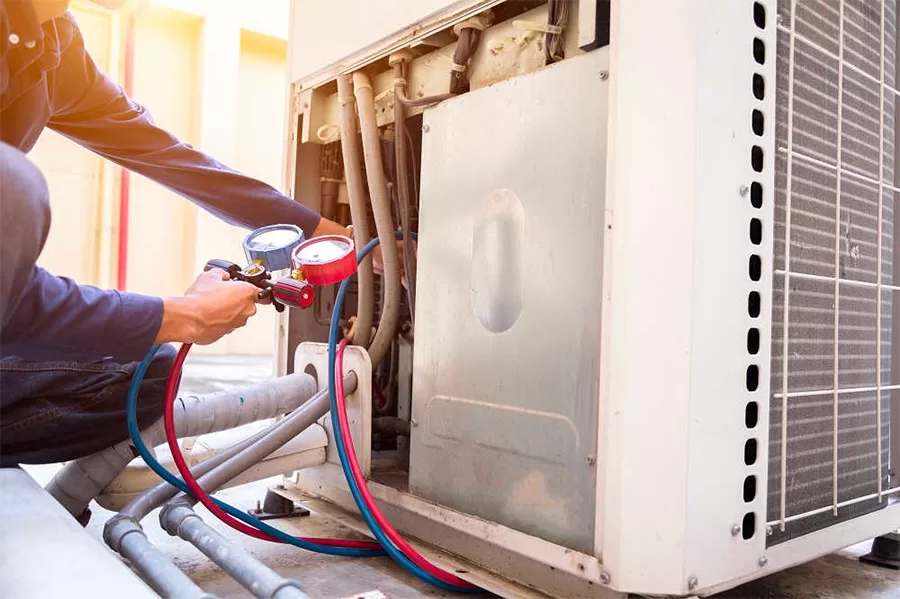
Modern air conditioners have many intricate parts, so for instance, if something needs replacing or the entire system needs servicing, then seeking a trained technician is definitely recommended. Hiring someone with the appropriate amount of experience and skill can make all the difference in keeping your AC running efficiently. Furthermore, getting stuck into a preventive maintenance plan will benefit you and your HVAC as it encourages appropriate service intervals to diagnose issues before they become major problems. In the long term going through these routine checks makes a world of difference when it comes to upholding comfort within any given space.
Preventative Air Conditioning Maintenance
Regularly maintaining your air conditioner is the best way to ensure it runs efficiently for years to come. Investing in preventative maintenance can be more cost-effective than dealing with costly repairs later down the road. Catching an issue early often results in cheaper repairs or a simple replacement part. A reputable Denver HVAC company like JD’s Plumbing, heating and cooling in Denver can help you avoid these issues by setting up and following a regular maintenance schedule.
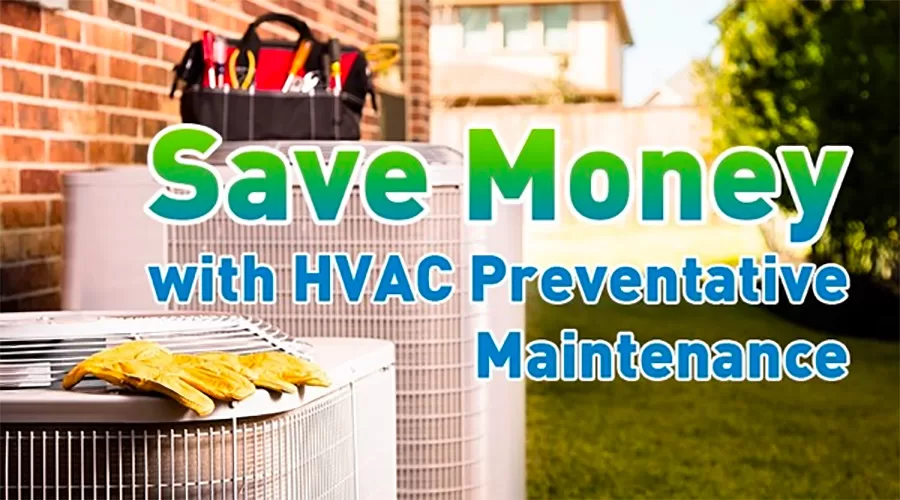
Your HVAC technician will regularly check your equipment and tune up all aspects, including refrigerants, filters, valves, motors, and fans. This helps ensure everything is calibrated correctly and running optimally while also allowing them to detect small problems before they become bigger ones that could strain your unit. Maintenance visits are also an ideal opportunity to get ready for seasonal temperature changes- technicians can adjust settings as needed so your system will run efficiently no matter the outside weather. An ounce of prevention is worth more than a pound of cure- don’t wait until it’s too late; invest in preventative air conditioning maintenance today!
Air Conditioner Repair
Getting an inspection and a tune-up on your air conditioner often is the best way to identify any potential problems that may need to be repaired. This will save you the headache of dealing with more significant, costly repairs down the road if left undetected for too long. During its lifespan, all air conditioning systems may experience some issue that needs repairing due to heavy usage over many years.
Common air conditioning repairs to keep your system in optimal condition typically involve the following tasks.
- Electrical problems – A professional should handle these due to the specialized training and equipment required.
- Short Cycling – This issue usually requires professional attention if the air conditioner decreases in functioning within a short period. First, inspect the filter to determine if it is blocked or dirty. If the filter passes inspection, a technician should be called to check for other potential issues.
- Duct Work – Inspecting the inside of your air vents is possible, but resolving any issues with blocked or damaged ducts requires professional assistance.
- Low Refrigerant – Professional assistance is needed to identify refrigerant leaks and restore the proper quantity.
- Failed Components – For any air conditioner repairs or replacements that require components beyond the filter, such as the blower motor or compressor, it is recommended to enlist the help of a professional to find the necessary parts and ensure proper installation.
Electrical malfunctions should never be attempted by anyone who does not possess professional expertise and tools. Cooling units use complicated networks of wires and parts, so it’s important to rely on an experienced technician with knowledge and resources to diagnose the issue accurately and restore your A/C unit’s original condition. In addition, other common air conditioner repairs include replacing air filters, checkups on motors, compressor diagnosis, freon charge, and multi-point tune-up, among a few other services that must be handled by a professional contractor.
Repair or Replace Air Conditioner?
Deciding to repair or replace your air conditioning system can be challenging. Constant maintenance is essential to keep your system running at its best, and it’s often wise to keep up with its upkeep over time rather than wait until something goes wrong and then scramble for a solution. However, when your air conditioning unit reaches the end of its predicted lifespan or it’s no longer able to provide you with an adequate level of comfort and efficiency, it may be time to consider replacing it.
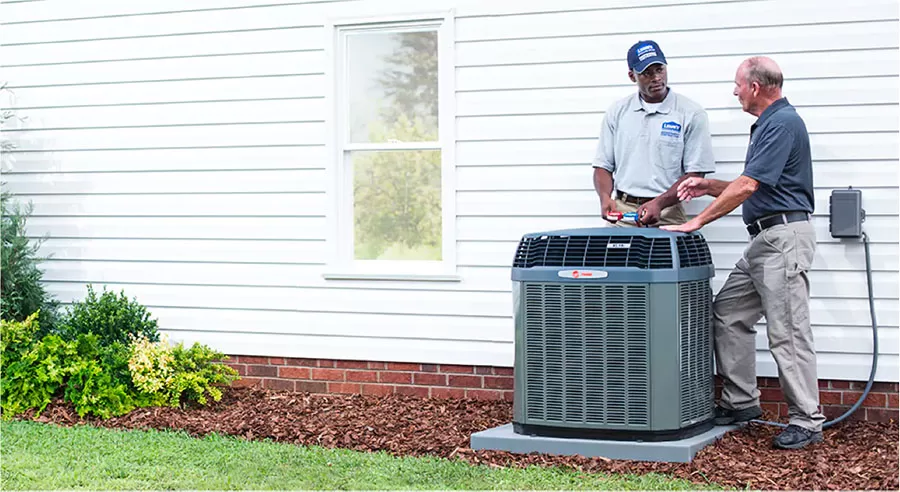
In this situation, working with an experienced HVAC professional is key. By having them assess the functionality of your current system, they will provide you with an honest opinion regarding whether repairs or replacements are the most suitable option for you. Furthermore, they have access to all possibilities available on the market that can help you optimize your AC unit to provide maximum performance and energy savings for years to come. Therefore, don’t hesitate to get professional advice from trusted companies in your local area whenever you need to make important decisions about maintaining or replacing parts of your A/C system.
AC Maintenance in Denver, Colorado
Maintaining an air conditioner in Denver, CO. is essential as the region’s hot weather can be very harsh. It is especially important to maintain your A/C unit since proper maintenance prevents costly repairs and breakdowns that may occur due to improper maintenance. To keep your A/C running smoothly, it is important to check for any signs of deterioration, such as strange noises, weak airflow, or air leaks from time to time. If you can’t diagnose any of these problems alone, contacting a qualified HVAC professional would be best.
Look no further than JD’s Plumbing, Heating & Air Conditioning Company for reliable air conditioner maintenance. JDs has been providing dedicated A/C services to the Denver area and are certified experts in every aspect of air conditioning repair and installation. With their knowledgeable technicians and dedicated customer service team, you can be sure that your cooling system will remain in top shape all year long! For maximum convenience, they also offer online appointment booking or if you prefer, you can directly call their support air conditioning team at 303-887-3356 with any inquiries.
Ensure a comfortable home or workplace by investing in our Plumbing, Heating & Air Conditioning services in Denver.
Keep This: A well-maintained heater lasts longer and stays efficient. But what does heater maintenance involve? The pros at JD’S Plumbing, Heating & AC cover heating maintenance in this section.
What is Heating System Maintenance?
In the United States, heating & air conditioning costs make up a huge chunk of a homeowner’s annual utility bills. With climate change taking place and temperatures getting colder, it’s even more important to ensure your heater is in top condition, or else you could be losing out on a lot of money. But proper maintenance isn’t just about saving money – it also ensures that your heater lasts longer without running into costly repairs or experiencing any breakdowns. It can also ensure that your system remains efficient, keeping your energy consumption at an optimal level throughout the year.
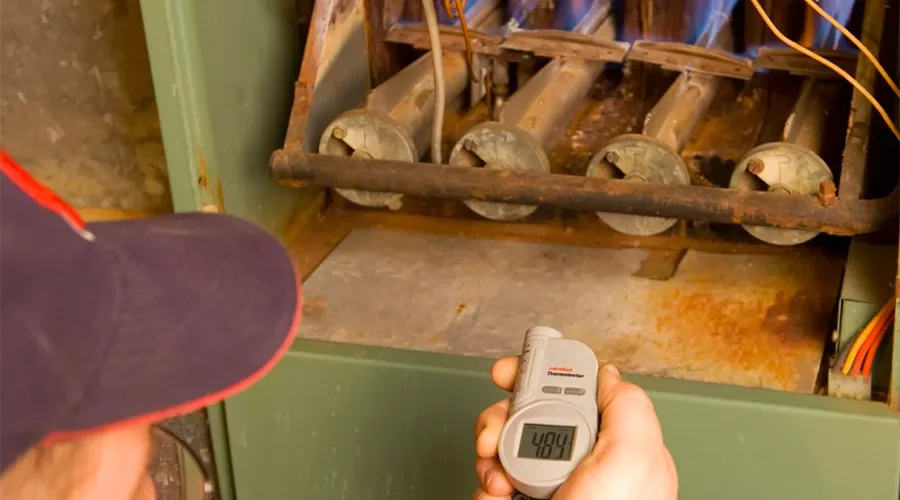
So what does proper heating maintenance entail? This guide will provide all the necessary tips and techniques for performing regular check-ups and repairs to keep your heating system running smoothly. It will delve into topics such as inspecting electrical connections, lubricating moving components, checking safety devices, assessing filters, replacing broken parts, and much more. Following these steps can ensure that you keep your home comfortable while not having to shell out too much money on unnecessary bills coming your way due to inefficient use of heaters.
Heating Systems: Overview
Heating systems are a crucial component of any home or building. They work to help regulate the temperature and make a living space much more comfortable in cold weather climates. First, they take in the cold air outside the house or building. Then, the system begins to heat the air. This can be done by burning fuel such as oil, gas, or wood pellets. An electric heating system is used to generate heat instead of using a fuel source. This heated air is pushed throughout the entire space to keep it warm.
In addition to regular systems that circulate heat independently, various features accompany different heating systems. For example, many types come with programmable thermostats that allow you to set your desired temperature for different times throughout the day and night rather than having always manually to adjust it yourself. They also may include variable fan speeds so that you can control how much hot air is being moved through different rooms based on how high traffic those areas are at certain times of day and other factors like insulation levels within walls and ceilings. Heating systems can be incredibly efficient when all their parts are functioning properly so it’s important for homeowners to pay attention to their heating system’s maintenance.
What Is an HVAC System?
An HVAC system is a modern technology used to ensure that people living in homes or other buildings have the right temperature and comfortable living conditions. The term “HVAC” stands for “Heating, Ventilation, and Air Conditioning” and is one of the most important elements of a building’s air system. An HVAC system affects the ambient temperature and ensures good air quality by managing air pollution levels.
Furthermore, many engineers design contemporary HVAC systems with technologies that can counter more drastic changes in air pressure. For example, during a storm, the system may detect any sharp decrease in ambient pressure, which will then equalize it accordingly to prevent negative side effects such as back-drafting. This makes our indoor environment reliable without drastically modifying its content by releasing contaminants into the atmosphere. Overall, an HVAC System brings much-needed comfort and assurance so both people and buildings can get some respite from any external climate conditions that may affect them negatively.
Types of Heat Systems
Various options are available when heating your home or office, ranging from HVAC systems to more unconventional methods. Heat systems can be divided into distinct types:
- Central air systems
- Furnaces
- Heat pumps
- Boilers
- Standard heating and ventilation systems.
- Geothermal energy systems are an energy source.
- HVAC systems with zoned valves.
- Direct heat
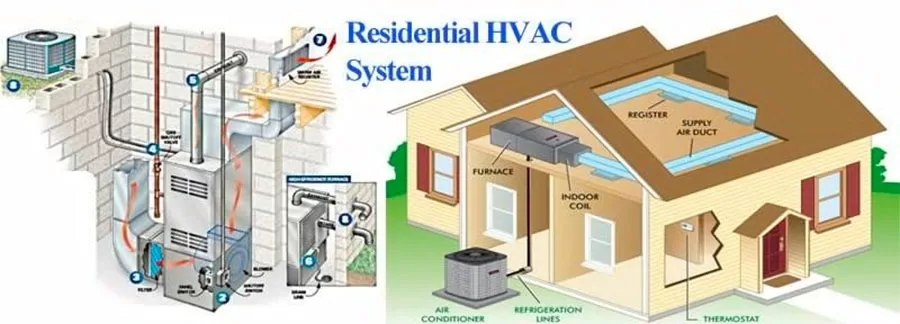
Central air systems are the most commonly used form of heating in both residential and commercial buildings. They can provide full climate control, cooling rooms during summer and warming them during winter. However, other options may need to be explored for smaller homes or apartments where large ductwork would not be feasible. Furnaces heat individual rooms via small vents in the walls or ceilings and are typically powered by natural gas; they are easy to install but lack the convenience of temperature control seen with central air. Heat pumps act similarly to a refrigerator but in reverse—transferring heat energy from outside air into indoor air rather than vice versa—but require specialized installation procedures to operate effectively. Boilers use heated coils that run hot water or steam through pipes into your home’s radiators; they are popular for their low running costs and excellent efficiency levels.
Standard Heating and HVAC Systems
Central air systems and HVAC systems are the most common type of central heating system; duct systems are a subset of these, in which air is heated by the furnace and circulated throughout the house through ducts. These ducts can be made from sheet metal or flexible insulated fibers, but usually, the latter is more recommended to keep energy costs down. The second subcategory, Hydronic systems, involves pipes that are connected to a boiler that uses hot water to heat the home. Hydronic systems are often seen as a more efficient means of heating & air conditioning because they maintain temperatures at a constant level longer than ducted systems.
When it comes to maintenance procedures for these types of heating systems, there are several things to keep an eye on, such as filters, ventilation fans, and parts of the furnace/boiler itself. Filters must be changed or cleaned regularly for your system to work optimally, while ventilation fans also need some attention now and again to make sure they’re not caked with dust or anything else. Finally, it’s important to check up on all the parts related directly to your furnace/boiler, including gas lines or electric connections. Regular upkeep of your system will generally equate to savings in both money and time, so it’s definitely worth a few minutes of your day.
Geothermal Heat Systems
Using geothermal heat systems is a great way to save money while still maintaining a comfortable temperature in your home or office throughout the year. A ground-source heat pump (GHP) harnesses energy from underground during the winter to provide a warm air source for the colder months.
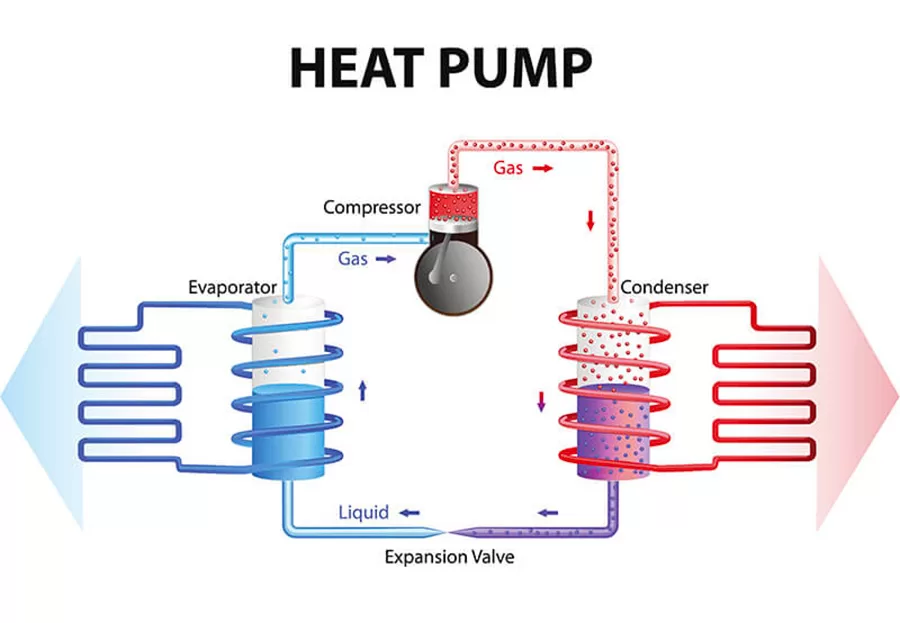
Organizations such as Geo Exchange advocate for more use of geothermal systems due to their cost-effectiveness and environmental friendliness. In many places, outdoor temperatures can change drastically from season to season, but dealing with these extreme variations has become easier thanks to geothermal systems. The temperature below the ground remains stable, making it ideal for regions with mild climates – where GHPs can cycle these naturally warmer underground airs upward to be used as a heating source during wintertime. Geothermal pumps are a great way to start saving on energy costs and reduce your reliance on traditional heating oil and gas heating systems.
Air Source Heat Pump
Air-source heat pumps are a fantastic option for those looking to heat their homes without using fossil fuels. Air source heat pumps don’t burn fuel to create hot air but instead take advantage of a chemical reaction that radiates heat.
The pump captures the heat and feeds into a compressor, which pushes the hot air indoors.
This type of system works similarly to ground-source heat pumps, though it has some advantages over GHPs. For one, you don’t have to break ground and install an elaborate underground tubing system like you would with a GHP. Additionally, since gasses are not used in creating air-source heating, these units can be much more energy efficient than a traditional furnace or boiler. By taking advantage of this technology, homeowners can save money on their heating & air conditioning bills while helping the environment by reducing their carbon footprint.
Direct Heat Options
Direct heat options are ideal for heating small areas within a home. These types of heaters generally cannot heat multiple rooms or an entire house. The most commonly used direct heat option is the space heater. Space heaters are powered by electricity and generate localized warmth wherever they are placed. Other common direct heat options include radiators, which use gently burning flames to generate warmth, and convection heaters which utilize electricity to heat a fluid and then use fans to circulate the air heated by the fluid throughout the room.
Whichever of these direct heat options you may choose, it is important to consult with local electrical codes as they may vary from region to region and could mean your choice of heating method is deemed unsafe in certain areas. It is also critical to make sure you are buying models with safety features, such as a safety shut-off feature that will cut power if the system overheats or someone comes into contact with it. Moreover, always ensure that any direct heating appliances you purchase have been properly installed and tested by a competent professional before use.
Heating System Parts and Purpose
The parts of a heating system should be diligently inspected, maintained, and repaired to ensure that the system is always running optimally. Each part has its own purpose to create the desired heating effect according to its functional parameters. For example, boilers are responsible for heating the water or steam used in many systems, while furnaces ignite fuel or electricity used to heat the air. Additionally, other crucial components such as radiators, exhaust fans, and piping help transfer hot air and steam into different spaces throughout a building.
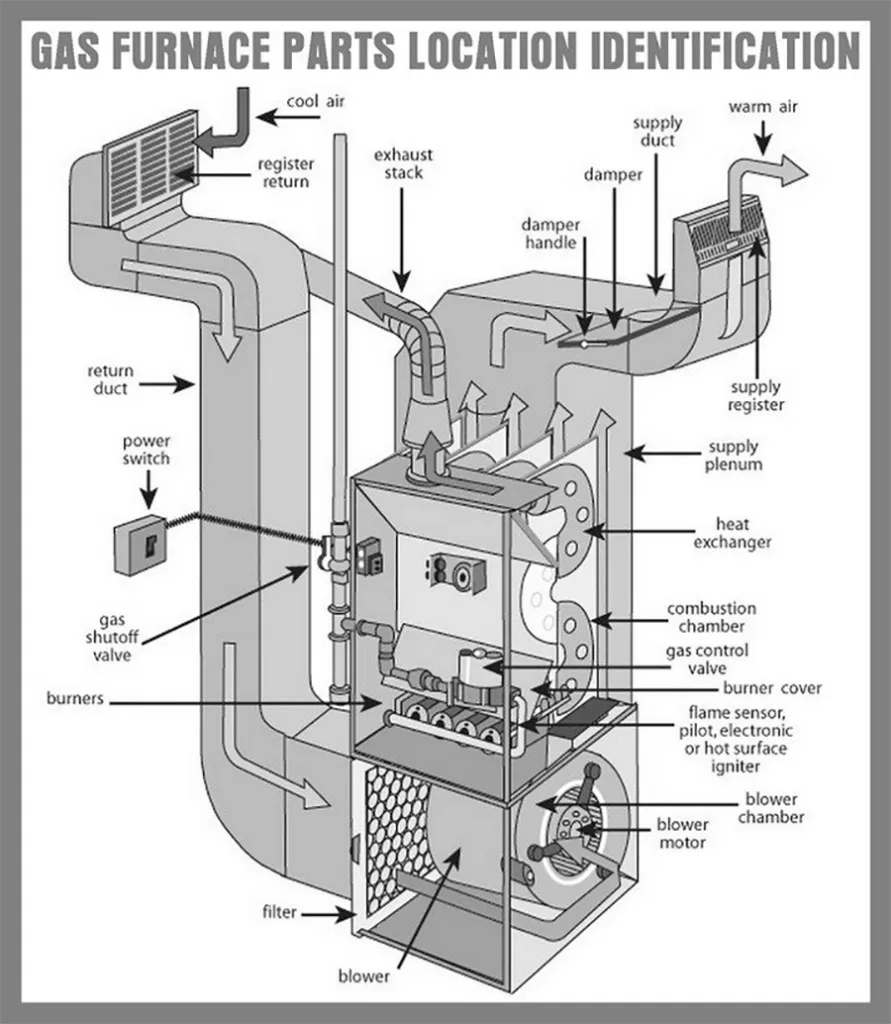
It is important to regularly check all parts of your heating system for signs of wearing and damage, as different parts bear varied amounts of risk. Strainers, valves, and ducts tend to have higher breakage rates than major components like furnaces; however, uninsulated pipes pose safety hazards like fire due to overheating due to poor insulation or leaks. Taking precautionary steps such as regular furnace repairs and maintenance can go a long way towards minimizing the risks associated with these key parts of your heating system.
What Are Some Components Of An HVAC?
- Thermostat: Regulates the temperature by controlling the HVAC system.
- Furnace: Provides heat for the building through burning fuel or electric resistance.
- Heat Exchanger: Transfers heat from the furnace to the air distributed throughout the building.
- Evaporator Coil: Cools the air by absorbing heat when the air conditioning is running.
- Condensing Unit: Releases the absorbed heat outside the building during cooling.
- Refrigerant Lines: Carry the refrigerant between the evaporator coil and the condensing unit.
- Ductwork: Distributes heated or cooled air throughout the building.
- Vents: Allow the conditioned air to enter rooms and the return air to go back to the HVAC system.
- Compressor: Circulates refrigerant through the system, enabling heat exchange.
- Electrical Wiring: Powers the components and allows the thermostat to communicate with the system.
- Blower Motor: Circulates air through the ducts and into rooms.
- Air Filter: Removes dust, pollen, and other particles from the air before it enters the HVAC system.
Fuel
Fuel is a common energy source used to power heaters, with natural gas the most popular option for residential uses. This versatile fuel can be burned in various ways, through combusting it directly or using catalytic chemical conversion to generate heat that’s used to warm air or water. Burning natural gas produces energy with less environmental pollution than many other fuel sources, making it an attractive choice in terms of efficiency and cost-effectiveness.
Common fuel sources include:
The most common fuel sources for heaters are:
- Natural gas
- Coal
- Petroleum oil
- Vegetable oil (cooking oil)
- Animal fat
- Wood
- Refrigerant
Another mechanism for generating heat without relying on fuel is geothermal systems. Instead of burning a fuel source, these systems use electricity and transfer it to the earth to extract heat from the ground and turn it into warm temperatures within homes or buildings. These systems are highly efficient and require minimal maintenance besides standard occasional checkups. Geothermal power also emits fewer harmful gases associated with traditional fuel-burning methods and helps move people closer to eco-friendly energy solutions.
Thermostat
The thermostat has long been a staple in our homes and businesses, allowing us to keep the room temperature comfortable. It is a relatively simple device that takes user input and uses it to control the heating system – turning it on or off, depending on your preferred temperature. This ensures your environment is just as warm as you’d like it to be.
In more recent years, technological advances have brought about the invention of the smart thermostat. This type of device can learn people’s routines and climates and adjust accordingly. Smart thermostats can act pre-emptively, meaning they are better equipped than traditional ones to ensure consistent comfort in any space throughout the day and night. Some models are even intelligent enough to change their settings based on other factors such as outdoor temperature – saving energy in rooms no one is occupying while still keeping them at an ideal level when someone enters them again.
Zoned Thermostat
Zoned thermostats are a great way to control the temperature of individual parts of a house. This technology uses valves to split off various paths in ducts or hydronic pipes, creating “zones” that enable users to maintain different temperatures for different areas. The zoned system also consists of multiple thermostats – one associated with each zone – allowing you to adjust the temperature within one particular zone without impacting the overall settings in other parts of your home.
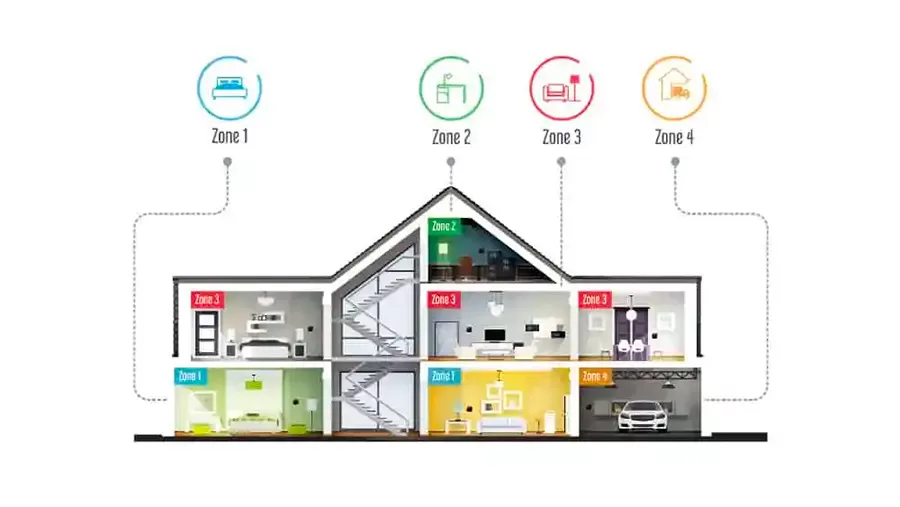
Setting up a zoned system is particularly advantageous if you have rooms in your house that get incredibly hot and others that tend to remain cooler. With hotter locations like an attic or a sunroom, it becomes possible to use less energy while greatly maximizing comfort levels throughout your entire home. And the basic control found on most thermostats makes it easy to access settings and make changes with minimal effort. Ultimately, these systems help provide customizable heating and cooling options that remove the hassle of controlling everything in one setting.
Furnace
A burner is an important furnace that allows a house to be heated. The way that these work starts with the burning of fuel to create hot air. This process begins when this fuel and outside air enter the furnace, then mix together when they are ignited. This combustion creates hot air that passes through venting, providing warmth throughout the building or home. Burners are essential components in standard heating systems as they help power HVAC and provide temperature-controlled air to structures.
Using a burner often coincides with programmable thermostat controls, which help regulate the temperatures inside by monitoring existing conditions in the room or space. The thermostat detects changes to properly adjust the flow of hot and cold air accordingly depending on certain factors like season and desired temperature setpoints selected by occupants. Without this combination of vital elements, most households or establishments would have no regularity regarding temperatures.
Combustion Chamber
A combustion chamber is a container that enhances and facilitates chemical reactions that generate heat. It is used primarily in furnaces and boilers, whose main purpose is controlling energy release from fuel burning. Combustion is the process of combining a chemical substance with oxygen, resulting in a reaction that creates heat. The combustion chamber acts as an insulated space for this process to occur, trapping and pressurizing the reactants – usually smoke or gas – within its walls to generate even greater levels of heat than would be possible without it.
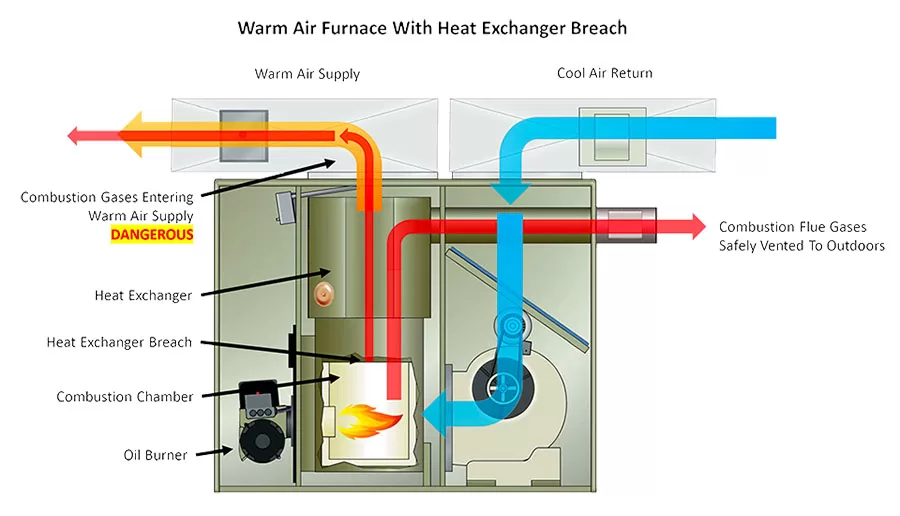
The combustive reaction inside a combustion chamber occurs extremely quickly, reaching upwards of two thousand degrees Celsius as fuel, usually composed of some hydrocarbon like oil or propane, is ignited under high pressure with oxygen-rich air. These temperatures are necessary when doing things like powering industrial engines or ships; however – it can also be dangerous due to an uncontrolled explosion occurring if flames come into contact with materials like metals or rubber outside of the combustion chamber itself. To overcome this risk, engineers have developed various safety protocols and mechanisms to ensure safe operation even inside particularly confined spaces such as automobiles and airports.
Boiler
Boilers are incredibly useful components of hydronic systems. Boilers provide heat to the home by burning fuel and boiling water until it turns into mostly vapor and steam. The resulting steam is sent through pipes under flooring and walls to transfer heat to different areas. This process works quickly and more efficiently than conventional heating methods, providing an ideal solution for those living in cold climates.
In addition to providing heat for a home, boilers can also be outfitted with special features that allow them to be used as a water sanitization system. By boiling the water, germs and bacteria can be killed, making the water safe to drink or use for bathing without additional filtration or sterilization processes. Boilers are an incredibly versatile tool that can save homeowners money while still achieving superior results when it comes to both heating and sanitizing their homes’ water supply.
Intake (Cold Air Return)
The intake, also known as a cold air return, is one of the most important parts of an HVAC system. It is essentially a register that inhales cold air and channels it toward the ducts. The intake consists of several components, including a grille that covers the opening to provide protection from debris and safety for curious fingers. Inside the grille are a damper and louver, which help regulate how much air is admitted to the system at any time.
Installing an optimal number and size of intakes in various rooms heavily affects performance; Too few intakes can result in stagnant air causing unpleasant odors or possible health risks due to inadequate ventilation. Similarly, too many intakes can cause uncomfortable drafts and reduce energy efficiency. Therefore knowing how many and what size of intakes are needed for each space ensures maximum energy savings and reliable comfort levels indoors.
Heat Exchanger
Heat exchangers are utilized to transfer thermal energy between locations or mediums. It is a form of energy, so when a heat exchanger is used, it helps facilitate the flow of thermal energy between two places. Hot coils, condensers, and evaporators are some of the various types of heat exchangers used in many systems today.
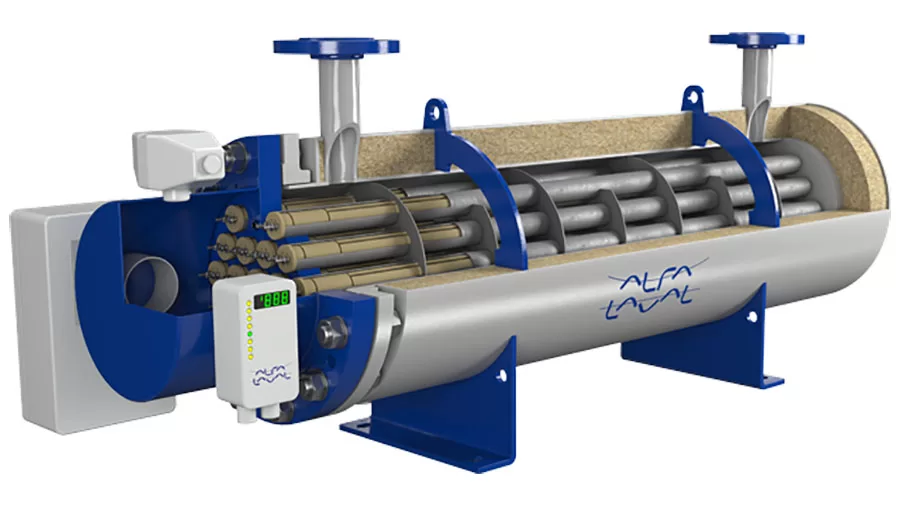
Air and heat pumps employ one type of heat exchanger – an evaporator – that works in tandem with the refrigerant it holds. When set into motion with heated air, this device starts a chemical reaction, releasing more heat. The process works because when you increase the hot temperature at a certain point, atoms become more excited and can carry more heat away from their surrounding area. Overall, using an air source heat pump captures that extra released heat and transfers it to another place – like a home’s ventilation system – where it can be utilized for further heating purposes.
Heat Pump
Heat pumps are an efficient way of transferring air from one place to another, usually for heating and cooling. They use mechanical energy to move air around, usually powered by electricity. A heat pump consists of a compressor and two coils: an evaporator coil that absorbs the heat from the outside environment and a condenser coil that transfers it into an indoor space like a home.
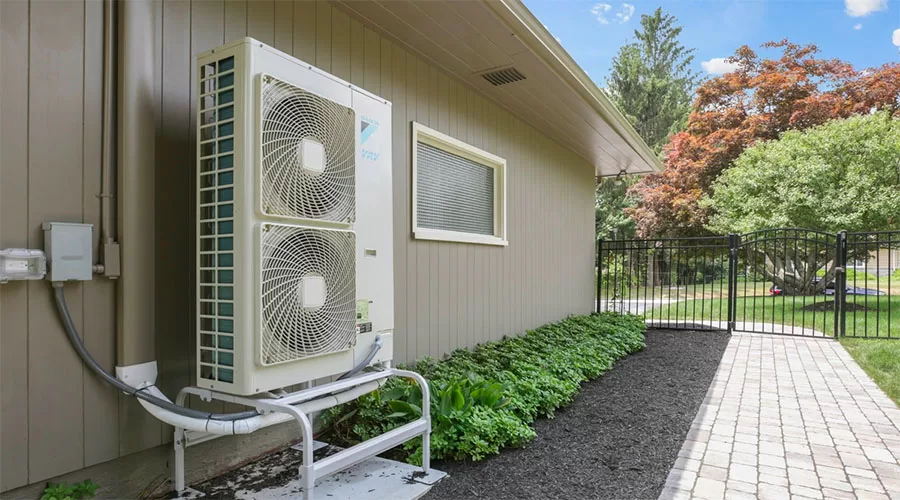
Heat pumps offer homeowners increased energy efficiency compared to traditional heating methods like gas furnaces in that they give more energy out than is used to run them. This makes them extremely economical, whether you’re trying to warm up your home during the winter or cool it down during the summer. Geothermal heat systems and air source heat pumps both use heat pumps as their resource of choice when transferring air. These machines are built with reliability and can come with warranties when installed in your home, giving you peace of mind when managing temperature extremes in your area.
Condenser and Evaporator Coils
The condenser coil is a critical part of “split” HVAC systems and is used for heating and cooling the air. This coil is located outside the home in an HVAC unit known as the condenser. It is part of a larger system that allows heat exchange between the refrigerant circulating within it and outdoor air. Condenser coils usually consist of copper or aluminum tubing bent into various shapes, surrounded by aluminum fins designed to provide maximum surface area exposure to the surrounding air. The airflow over the coils helps dissipate heat into the outdoors while lowering pressure to convert it to liquid form. If this critical furnace coil begins to malfunction, it can cause major issues with your heating and air repair and require immediate attention from an experienced technician.
The evaporator coil, commonly known as an ‘A-coil’, works with the condenser coil in split HVAC systems. Its purpose is to cool indoor air via latent heat exchange, where warm household air refers to cool on contact with its metal surface, enabling hot gases in this heated moving fluid state to be turned back into liquid form for removal from your indoor environment. Evaporator coils must also be regularly checked and serviced as they can become clogged with dirt and debris, reducing their efficiency over time.
Blower (Fan)
A blower is essential in heating, ventilation, and air conditioning (HVAC) systems. It’s a centrifugal fan with sharp blades rotating around the hub. As the blades spin, they create an impeller – a kind of specific rotor that increases the pressure and flow speed of an air-based fluid. This unique engineering design produces more consistent air temperature and pressure levels within ducts, helping to heat or cool indoor environments efficiently.
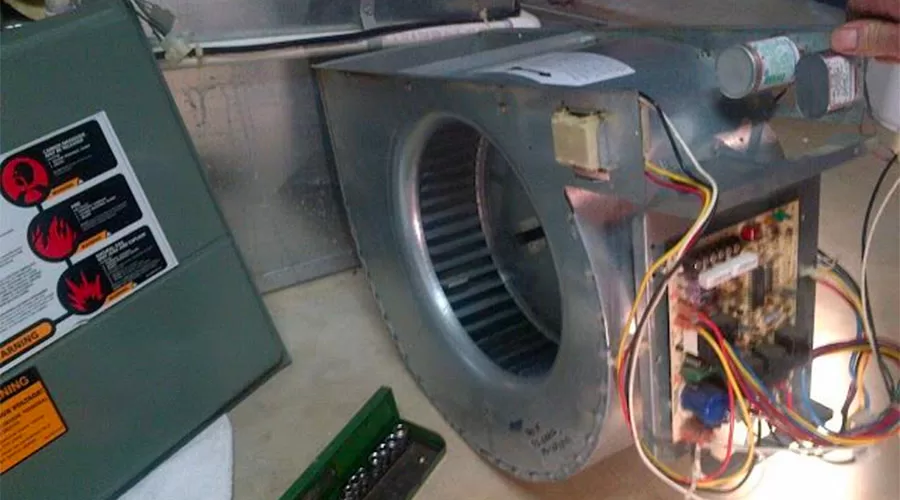
Blowers are significant components for those who require HVAC equipment in areas such as offices and homes. Specifically, their fast-rotating impellers make it possible to quickly change the direction and speed of air movement along ducts without adding additional equipment to facilitate airflow. Blowers provide air conditioning through HVAC systems that are increasingly efficient, resulting in lower energy bills and greater assurance.
Ducts and Vents
Ducts are essential to any heating, ventilation, and air conditioning (HVAC) system. They provide an enclosed passage for air circulation and are usually made from metal or plastic with various configurations. The principle is similar to that of a river flowing down its riverbed: air flows in various directions throughout the ducts. Ducts allow you to divert airflow in multiple directions, creating changes in temperature and humidity within a space while protecting against contaminants that enter through outside sources like walls or windows.
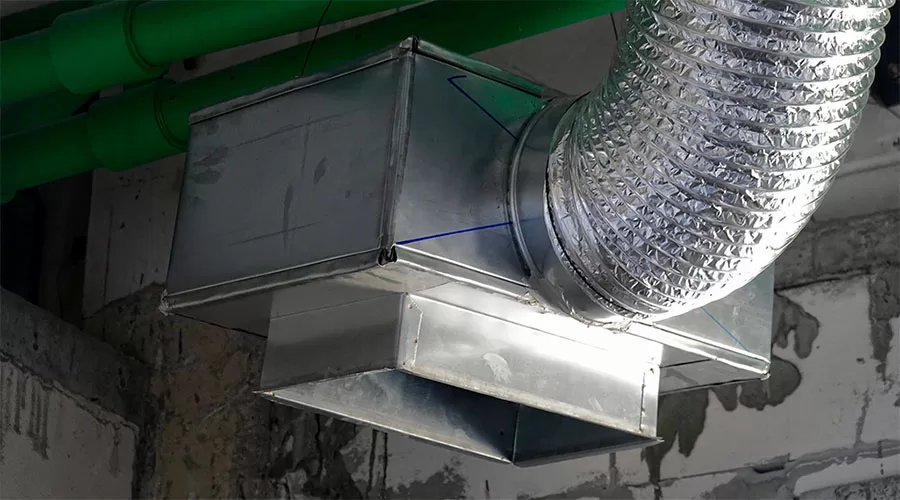
In a typical HVAC system, three types of air travel through ducts – supply air, returning air and exhaust airflow – enabling zones to be heated or cooled quickly and efficiently. Supply air generally travels at higher speeds than return air because it has more pressure behind it; cool air is pushed away from the conditioned area, while warm air is pulled into it. Additionally, exhaust fans are often placed near bathrooms and laundry rooms to expel all unwanted odors from the home physically. Without these vents, potentially harmful fumes could accumulate inside living areas. With proper furnace installation, ducts can ensure your space is properly conditioned year-round with clean air quality indoors.
Supply Air
The supply air system is crucial to climate control in homes and businesses. It ensures that the right air temperatures reach each room and space. To do this, the system carries the conditioned air through small supply ducts until they end at supply vents. The vents are usually equipped with grilles and slats, which keep the circulating air at a consistent temperature.
The supply air then flows into each room, whether it’s heated or cooled, depending on the season or desired temperature by its users. This high-quality temperature-treated air enters us through these vents, cooling us on hot summer days and warming us up in winter evenings. Without the air from these systems, we would not be able to regulate our natural comfort levels both inside and outside the house quite as well!
Return Air
Return air is a key part of any HVAC system, helping ensure air is circulated through living spaces efficiently and effectively. The system pulls air from interior rooms, such as bedrooms and living areas, back towards the main return ducts. These ducts are typically larger than outflow ducts to allow for more efficient circulation and then lead directly back to your furnace unit located in the garage or exterior of a structure.
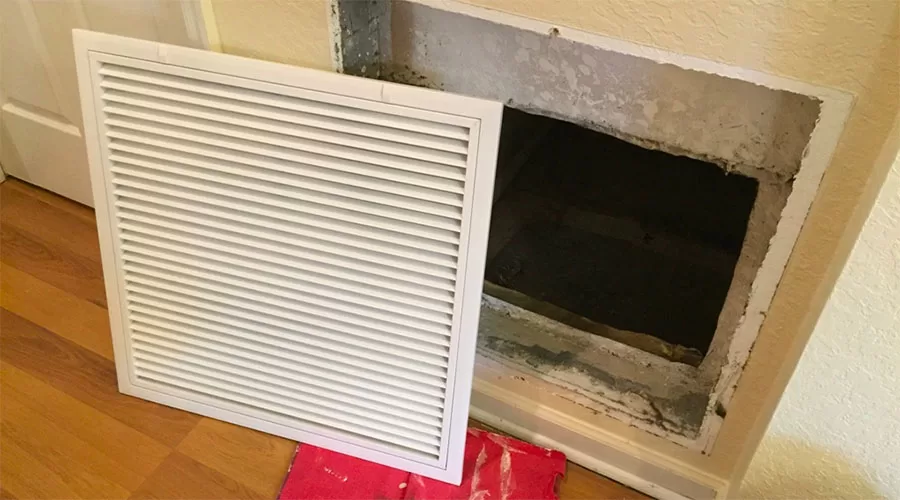
The design mechanics require that each room has its own specific return vent. This can be found near the floor level, identifiable due to its larger grill than those associated with outflow vents. By strategically placing these vents near the base of walls, designers can ensure airflow moves efficiently through all areas of the home. Some builders will also add filters in select locations, which help improve air quality over time. Return air is critical in HVAC systems and should always be properly installed for peak performance levels.
Exhaust Air
Exhaust air from HVAC systems is necessary to keep a home comfortable. While the air emitted by these systems is not considered harmful, it can be quite hot due to how quickly the exhaust vent expels it from the building. Hot air expelled from an HVAC system typically passes through an exhaust pipe and then through ducts to be outside the building. This allows for safer and more effective ventilation since no one inside the building is exposed directly to hot air emissions.
The role of an exhaust pipe in an HVAC system can be critical depending on the needs of each individual room or space. Exhaust pipes exist to expel excess heat or warm air out of a room that may arise due to other equipment like computers or machinery operating inside. The warm air is typically drawn away by a fan or wall-mounted vent that runs through several ducts connected until reaching its designated outlet point– usually located outside and away from any inhabited area. Installing without proper safety measures could lead to injury and discomfort, so professional help should always be sought when installing and maintaining HVAC exhaust systems in any space.
Non-Duct / Ductless Systems
Ductless systems are solutions that do not require ducts to move the hot air or heated liquid throughout the home. Hydronic systems use coolant circulated within pipes to provide heating and sometimes cooling. Direct heaters, such as those powered by electricity, fuel, or wood, generate heat without requiring ducts. Heat pump systems may also be installed without ductwork; these systems absorb warmth from one space and transfer it to another by means of a refrigerant cycle. Although many people opt to integrate heat pumps into pre-existing ductwork as part of an overall central air system, they can also be used as standalone units requiring no connection whatsoever with any existing infrastructure.
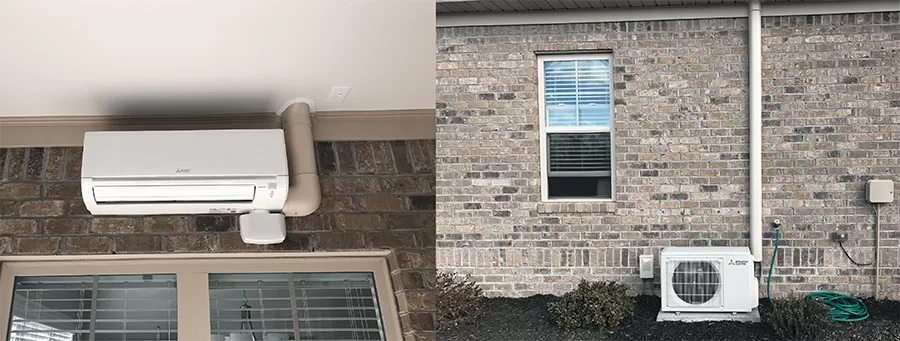
Overall, plenty of alternatives to central air heating systems use ductwork. Hydronic and direct heater mechanisms offer customers focused delivery of hot air and/or liquids while avoiding complex installation processes along with potential associated costs. Heat pump systems provide an all-in-one solution for temperature control, regardless of whether you choose to go with integrated outlets or independent freestanding units. All three of these non-duct solutions offer various features enabling homeowners increased control over how exactly their energy is being efficiently utilized inside their homes, thus, saving them money in the long run.
HVAC Ductwork Design
Properly designed ductwork is essential to the efficient functioning of an HVAC system. A mechanical engineer must carefully plan out the layout of the ducts and determine what type of material will be used. Most commonly, these materials include aluminum, steel, and polyurethane. Aluminum is lightweight and easy to install, making it the preferred choice in many cases. Steel is also popular due to its strength and durability, although it requires more maintenance than aluminum. Polyurethane provides excellent insulation value, making it well-suited for areas with extreme temperature fluctuations. Regardless of which material is chosen, it’s important that good quality duct tape or even welding is used for any connections so there are no leaks or reduced airflow, which can impact overall efficiency. You can ensure your system works at its best by properly designing HVAC ductwork with quality materials and installation practices.
Filters
HVAC filters are important for capturing dust, mites, pollen, and air pollutants before reaching you. Without these filters, the air quality of your home would quickly fall. The filter is usually accordion-folded fabric with pleated fiberglass, paper, or cloth inside. This combination helps to strain large pieces of solid particles out of the air as it passes through. These filters can be found in your return air duct system, which typically has two filters in most homes.
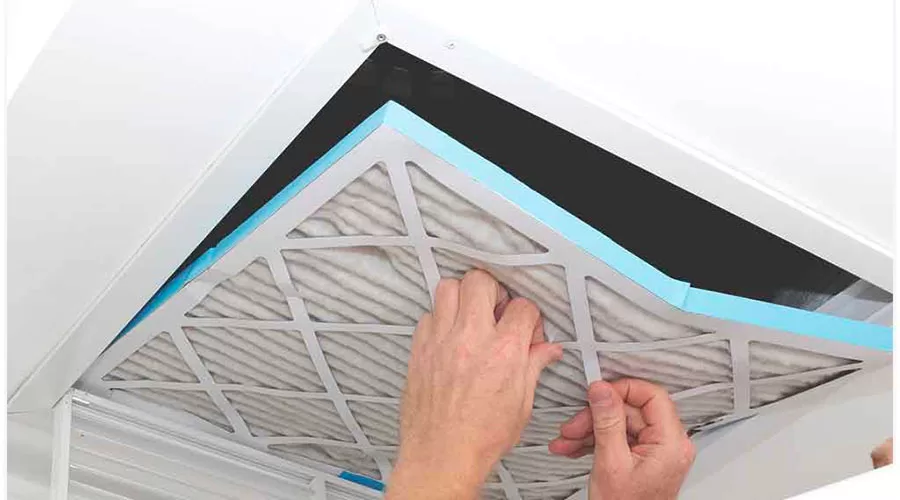
The number and type of filter you need depends on your HVAC system’s size and how powered it is running. The higher-powered systems require tighter weave fabrics to capture smaller particles, while longer run times mean disposable filters often make better sense than reusable ones. You should always follow manufacturer instructions to maximize effectiveness and ensure a good level of air filtration. However, even if you have an excellent filtration system that sometimes catches small particles, larger pieces can still pass by it so regular cleanings are recommended too.
Heater Maintenance Checklist + How-To
Good heater maintenance is essential to the safety and efficiency of your heating system. It’s a good idea to perform regular, thorough heater maintenance checks at least once or twice per year. With regular maintenance, your heater can run safely and efficiently for years.
To keep your heater running in top condition, it is important that you complete tasks like inspecting the housing units and checking for leaks or other potential problems. Additionally, it would be best to inspect wiring, belts, hoses, filters, fluids levels, and seals regularly to ensure there are no wear points in any components. Depending on your heating system type, some tasks may include cleaning burners, replacing gaskets and wax rings if needed, and lubricating any moving parts where required. Be sure to check your manufacturer’s manual for detailed instructions on maintaining your heating system. Lastly, always be sure to turn off pilot lights before servicing furnaces or boilers as part of a required safety precaution in case of gas leaks or other issues with the burner assembly. Doing these periodic steps yourself can make all the difference when it comes to extending the life of your heating system while keeping it safe and cost-effective throughout its life span.
1. Check Thermostat Settings
Maintaining your thermostat’s settings is essential to keeping your home comfortable year-round.
To ensure your thermostat is set correctly, compare the room temperature with a thermometer to the thermostat’s reading. If there is a discrepancy of several degrees, consider adjusting your thermostat.
2. Fix Electrical Connections
Identifying and fixing electrical connections can be tricky. Blow fuses are one of the most common causes of shorts in your HVAC system. When a fuse blows, it re-routes electricity away from that part of the system. To determine if a short has occurred, the first step is to turn off the power at the main breaker or circuit connection.
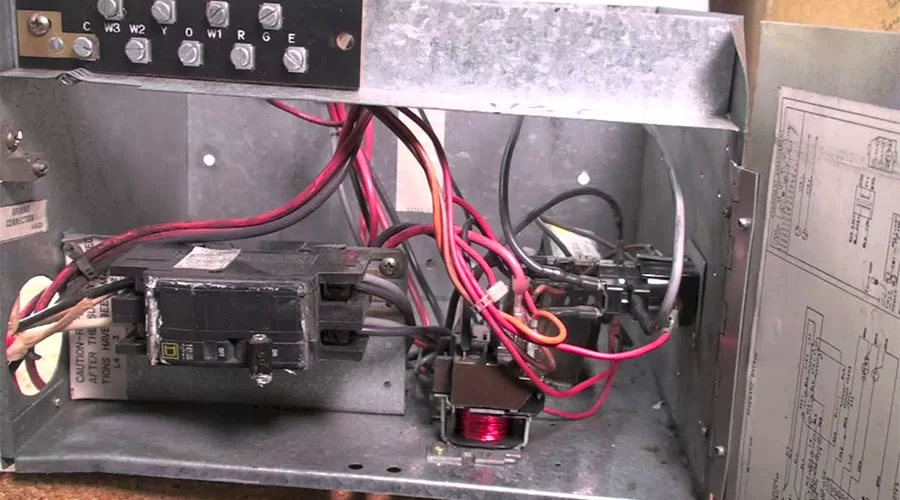
After powering down, you can use a multimeter to check for and detect any shorts that may have occurred. The multimeter will help identify where the current isn’t flowing correctly and point you toward what part needs to be fixed or replaced. When using this tool, make sure to follow all steps in the multimeter’s manual so you don’t accidentally hurt yourself or damage your HVAC system even more. After getting all the required information, use tools like wire cutters and electrician screws depending on what needs replacing or resetting as per requirements or instruction manuals that come with an appliance.
3. Lubricate Moving Parts
Moving parts in machinery or electronic systems require periodic lubrication to ensure maximum performance. Applying the right lubricant can reduce friction and wear on the system components. This will preserve the life of machines or electronics since friction increases the heat, which can damage internal mechanisms.
The first step is to consult the manufacturer’s manual to identify which type of lubrication works best for each particular machine. It is important to use lubes that are specified by the manufacturer, as these would be designed to work specifically with that machine’s components. Once you know what kind of lube you need, apply it evenly and sparingly on all moving parts before reassembly of those components. Try not to overload with too much lube, as this could affect how well the parts interact with each other. Additionally, check periodically whether more lubrication is needed based on signs from your system’s performance and possible wear-and-tear signs around connected areas. Taking good care when lubricating your system will ensure its smooth operation over long periods of time.
4. Clear the Condensation Drain
If you’re dealing with a clog in your home’s condensate drain, don’t worry. Clearing it out is easy to do and doesn’t require any special materials or tools. First, make sure to shut off the system: turn off the pump or AC unit, then locate the condensate drain line’s access point.
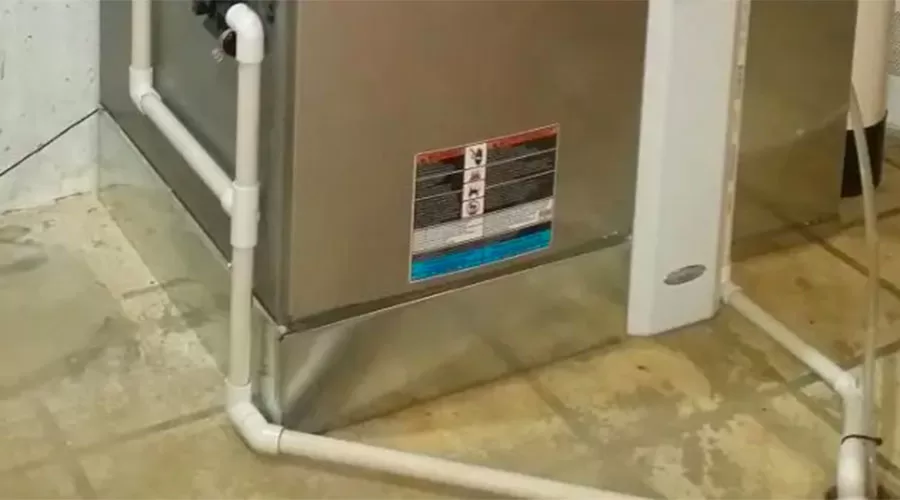
Once you’ve located the drain line’s access point, flush distilled vinegar through it and let it sit for 30 minutes. This will help break down and liquefy any debris, grease, or minerals that were blocking the flow of water and causing the clog. After this time is up, all that’s left to do is turn your system back on—you’ll have a good flow of water again.
5. Check Start and Shut-Off Cycle Controls
Start and shut-off cycle controls are important for any modern home heating system. They allow for optimized energy usage and efficient climate control conditions throughout a living space. These controls must remain in proper condition to keep a home’s indoor temperature comfortable and consistent.
Before inspecting the start and shut-off cycles, looking up your HVAC system’s manufacturer manual or website is helpful. This will provide insight into how the particular model of furnace your house utilizes works, as well as what type of maintenance might be required to ensure its proper function. After locating the start and shut-off controls on the systems control panel, check it closely for any damage, grime, melted parts or disconnected components. If any of these items are found, then repairs should be made immediately to avoid further issues with the overall functioning of the home’s heating system.
6. Check Natural Gas or Oil Connections
The first step is to locate the furnace or boiler to check natural gas or oil connections. Check for any unusual sounds emanating from the point where the natural gas or oil feeds into the chamber. Look out for any vibrations or rattling sounds, as this could indicate an underlying issue with your connections. You should also listen for any hissing noise, as this could indicate leakage in the connection, which may need attention.
As well as listening out for noises and sounds, you should also look closely at your furnace or boiler, looking for signs of soot or smoke. If you observe any of this, there is likely an issue with your connection. It should be checked immediately by a professional who can identify and solve any potential issues before they worsen.
7. Check Gas Pressure
Checking gas pressure is an important task for homeowners that use gas appliances to heat their homes. If the pressure is too low or too high, it can cause many problems, including inefficiency and even complete malfunctions of your furnace or boiler. To make sure you achieve the proper pressure, it’s necessary to measure it with a manometer.
A manometer reads gas pressures in SI (Standard International) units which are used across the world. To read the pressure, most furnaces/boilers will have either an MPT plug outside of the gas valve or a tower connection point on top of the valve that enables you to take a reading. When properly connected, you can take readings from your manometer and adjust accordingly. If needed, a professional should change the actual regulator so you don’t create any hazardous conditions in your home when dealing with such combustible materials.
8. Examine Burner Combustion
The combustion test is important for ensuring a hydronic heat system’s safe and efficient operation. The combustion test allows technicians to identify any potential problems with the heater, such as the presence of carbon monoxide or other hazardous fumes that can be produced during combustion. The technician will use specialized testing equipment to measure the air intake, fuel consumption, CO2 values, and other measurements while running the unit on a full cycle.
The combustion test determines whether your fuel burns efficiently and all products are exhausted safely from your home. If a technician determines that there is an imbalance in your system’s burning efficiency or that harmful emissions are present, he or she may suggest making adjustments to repair it. Additionally, this test can help identify any issues with an older heater due to issues such as wear and tear on components. A successful combustion test should result in improved performance of your hot water heater and decrease your energy consumption over time.
9. Check Heat Exchanger
Checking a heat exchanger ensures your home or workplace is safe and protects you from carbon monoxide poisoning. The primary way to check a heat exchanger is to pay attention to the flame since it typically should remain steady.
A sudden change in airflow when the blowers turn on, can indicate a leak. Professional technicians may use a variety of tests, such as combustion analysis or isolation pressure testing, to check heat exchangers. While these more involved tests require more skill and experience, they will provide more accurate results than rely on flame observation. It is also important to note that if the exchange is dysfunctional, you must take proper safety precautions, such as ventilating the area and having the issue inspected by professionals before returning to normal activities.
10. Change Air Filters
Changing air filters every month is important to maintaining a healthy home. It helps improve air quality, reduces allergies, and even increases energy efficiency. Luckily, changing the filter is a relatively simple task, but taking all necessary safety precautions is important.
Before changing an air filter, start by turning off your HVAC system. This will prevent any accidents or injuries that could occur from contact with the fan blades. Next, locate the return ducts and furnace, where you’ll find an access panel displaying the correct filter dimensions for purchase and replacement. To replace the old filter, slide out the previous one and insert the new one in its place, ensuring that it’s secured properly before continuing. Finally, switch your HVAC system back on after replacing your air filter, and you’re good to go!
Save Money on Your HVAC Energy Bills
As the temperature drops, many homeowners pay more for their heating bills. However, there are several ways to save money on your HVAC energy bills while still keeping your home warm and comfortable. One of the easiest ways to save money is to ensure your HVAC system runs efficiently by scheduling regular maintenance checks.
Here are five other ways how to save money on your HVAC energy bills
1. Use a programmable thermostat to adjust the temperature in your home according to your schedule. This way, you can lower the temperature when you’re away or asleep and raise it when you’re home and awake.
2. Seal any air leaks in your home, such as around windows and doors, to prevent cold air from entering and warm air from escaping.
3. Invest in insulation to keep your home warm and reduce energy costs. This can include adding insulation to your attic, walls, and floors.
4. Clean or replace your HVAC system’s air filters regularly to ensure that it’s running efficiently and effectively. A dirty filter can cause your system to work harder and use more energy.
5. Consider upgrading to a more energy-efficient HVAC system, which can save you money in the long run by reducing your energy bills and improving your home’s overall energy efficiency.
By following these tips, you can save money on your HVAC energy bills while still keeping your home warm and comfortable throughout the colder months. With a little effort and investment, you can reduce your energy consumption and save money in the long run.
Heating Maintenance FAQs
Understanding how to maintain your heating system can be overwhelming. Knowing what type of system you have, what all of the parts are, and what regular maintenance tasks to do is a lot to take in all at once. Fortunately, we have answers available for any lingering questions about heating maintenance you might have.
We’ve covered everything from spring start-ups, filter replacements, and cleaning the blower wheel to duct inspections and filling out warranty cards – all the essential information necessary for the ongoing care of your heating system that will keep it running efficiently. With our comprehensive collection of FAQs, we have the resources you need if something comes up or your system has a problem. Our knowledgeable and reliable staff is here for every question you might have about your heating system and how best to look after it.
How to Maintain a Heater?
Always refer to the manufacturer’s manual for guidelines and recommendations, no matter the heating system. If this does not provide answers, seek professional help. As a best practice, cleaning out any clogs in filters and drains at least once every month, but not later than sixty days, is advisable.
It is advisable to have regular maintenance done annually. Have a professional check-up once a year.
Knowing the risks associated with fire and carbon monoxide poisoning is important and following all relevant safety protocols is important.
When to Maintain, Repair, or Replace a Part for a Heating System?
There will be differences between systems and manufacturers regarding repairing or replacing parts. It would be best to look up your system’s manufacturer for their recommendations on repair and replacement needs. For example, many newer systems often have better warranties on parts, so it may be more beneficial to replace when necessary versus attempting a repair yourself. If you do choose to do repairs yourself, then researching DIY strategies is always an option; however, if the repair isn’t 100 percent successful, then calling in a professional may be worth it. Ultimately, understanding when the time for maintenance arrives and working with professionals who know what they’re doing will help you make efficient repairs when needed throughout the lifespan of your system.
How Often Should a Heating System Be Serviced?
Heating systems need to be serviced regularly to ensure they are working correctly and efficiently. An annual service of your heat system is necessary to guarantee maximum performance, reliability, and safety. If you have an HVAC system, check both the heat and AC sides twice a year for optimal functionality. A hydronic system should also be serviced each year, including draining down and servicing the pumps, checking all fluid levels in the system, cleaning out any debris that may have been collected, and checking sensors and pressure control valves as the overall condition of the boiler unit.
In addition to an annual maintenance outline for your heating system, you may also consider other parts specifically connected with geothermal systems. A geothermal unit requires a yearly acid flush to clear out tubing networks and protect them from corrosion or mineral buildup. Air heat exchangers should also receive professional maintenance once per year due to dust accumulation which can cause fan blockages or decrease airflow and efficiency gains in performance. Be sure that all individuals performing service on your heating systems are qualified professionals who can advise accurately on how often it should be serviced.
A geothermal unit requires a yearly acid flush to clear out tubing networks and protect them from corrosion or mineral buildup.
Air heat exchangers should also receive professional maintenance once per year due to dust accumulation which can cause fan blockages or decrease airflow and efficiency gains in performance. Be sure that all individuals performing service on your heating systems are qualified professionals who can advise accurately on how often it should be serviced.
What Does Furnace Maintenance Include?
Furnace maintenance and safety involves evaluating each system part and the performance of tests and tasks as previously discussed in the article.
Refer to the manual of your heating system for a full list of tasks. You should check with any repair professional you intend to employ about which tasks they cover.
Furnace maintenance should also include the cleaning of the furnace and its parts. It is also important to check for gas leaks around the system. If you detect a leak, shut off the gas immediately and call a professional to inspect the system.
How Much Does Heater Maintenance Cost?
Heater maintenance costs vary greatly depending on the type of heating system, the age and condition of the system, where you’re located, and much more. Generally speaking, it’s important to regularly maintain any heating system to keep your home comfortable and energy efficient. The Energy Information Administration states that average yearly maintenance for most systems costs between $90 and $200. This excludes additional costs if system parts require repair or replacement.
It’s important, however, to do some research and talk to a qualified professional regarding what type of heater you have and what kind of regular maintenance is best suited for it. You can ask an insurance company, contractor or dealer for their advice for maintaining your particular heater. While it may cost more upfront in professional fees and labor, ensuring that your heater is regularly maintained can save you money over time and avoid breakdowns at the worst possible times!
How to Find Heating Repair Near Me?
Finding the best HVAC services and heating repairs near you can be easier than you think. JD’s Plumbing, Heating, and Air Conditioning offers its services in numerous locations, making them accessible to many. To locate the closest branch to your home or workplace, you can contact them through their website by clicking the Contact Us link. This is a great way to minimize the hassle of needing a repair and finding someone local to do the job quickly.
Once you have entered your information into JD’s Plumbing, Heating, and Air Conditioning website, they will provide an estimate for services and priority scheduling for one of our certified technicians to come to your property and take care of any needed repairs.
Depending on the nature of the issue and what needs to be done, we offer same-day or next-day service appointments, so you don’t have to wait long for your heating issue to be fixed! Not only that but all of their heating and HVAC repairs are also covered by warranties in case anything needs repair in the future.
In addition, their technicians are highly experienced in identifying issues quickly and providing cost-effective solutions based on customer budgets.
Get Heater and Furnace Maintenance In Denver, Colorado
When the cooler months of the year arrive, homeowners often find themselves in a race to get their heating systems inspected and serviced. Regular maintenance of your heater is important for proper functioning and helps save you money in energy costs and avoids expensive repairs down the road. Heater maintenance should be part of your regular home care checklist — it’s best to beat the rush now and get it taken care of today!
The importance of regular heater maintenance cannot be overstated. A professional technician will check your HVAC system to ensure everything is running safely and detect early signs of problems that can lead to breakdowns later. Checking performance, airflow, safety controls, fluid levels and flues are all part of a comprehensive annual service. Heater maintenance also involves changing or cleaning air filters for improved air quality in your home. Completing the necessary maintenance today ensures that vital components won’t break down unexpectedly when winter weather arrives in earnest! Scheduling this important task now will give you great satisfaction and assurance, knowing your heater is ready when temperatures drop.


